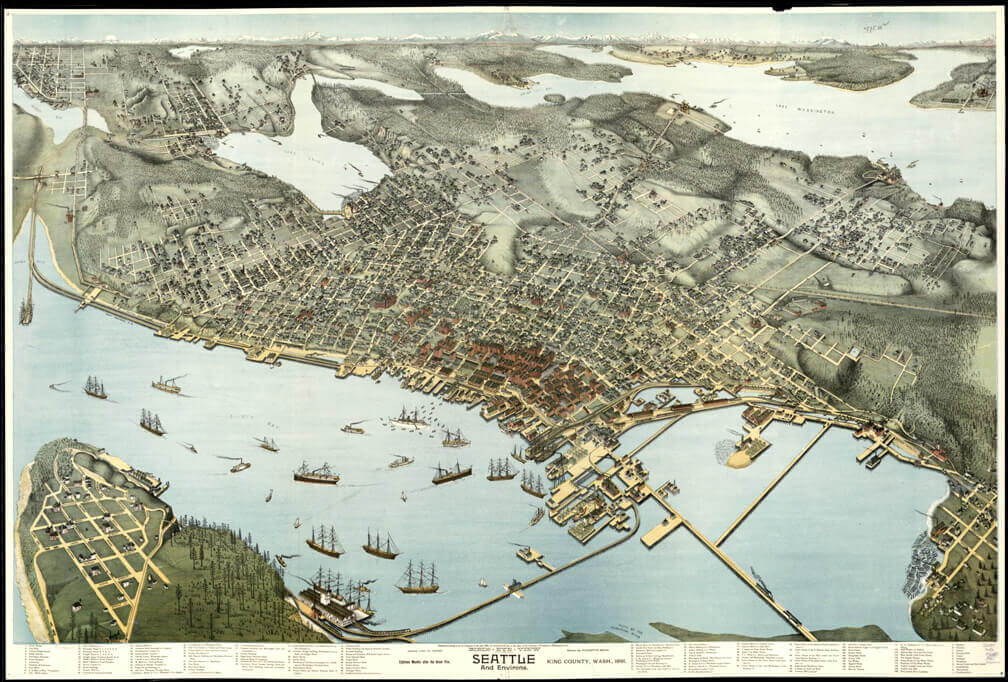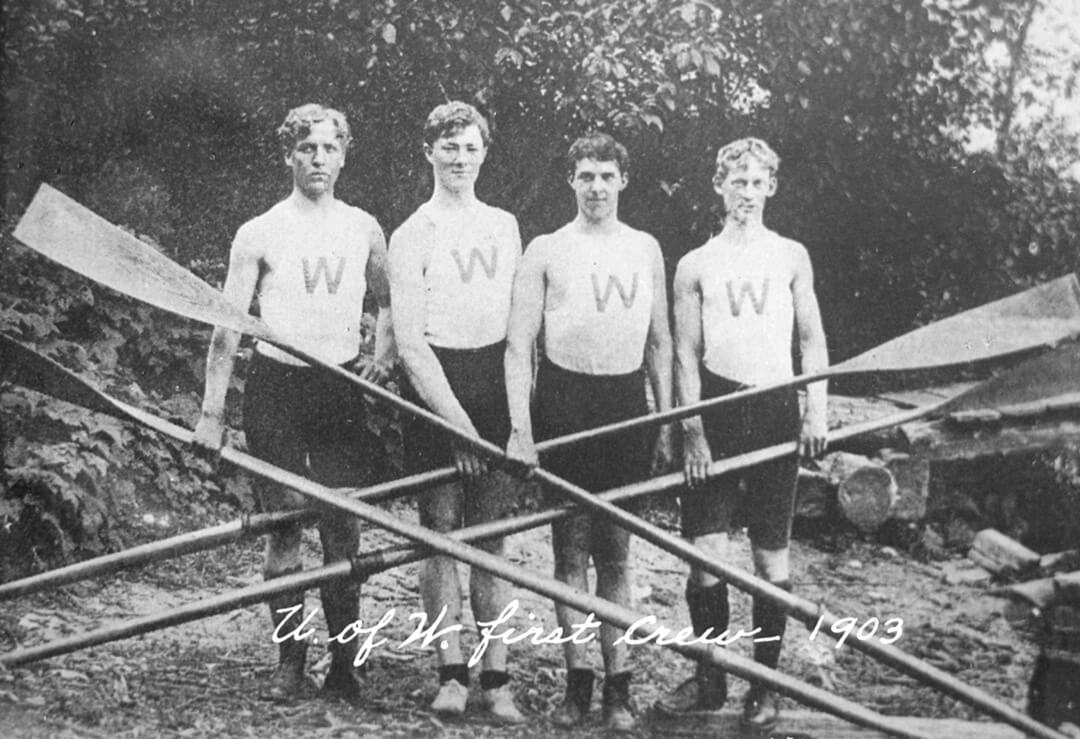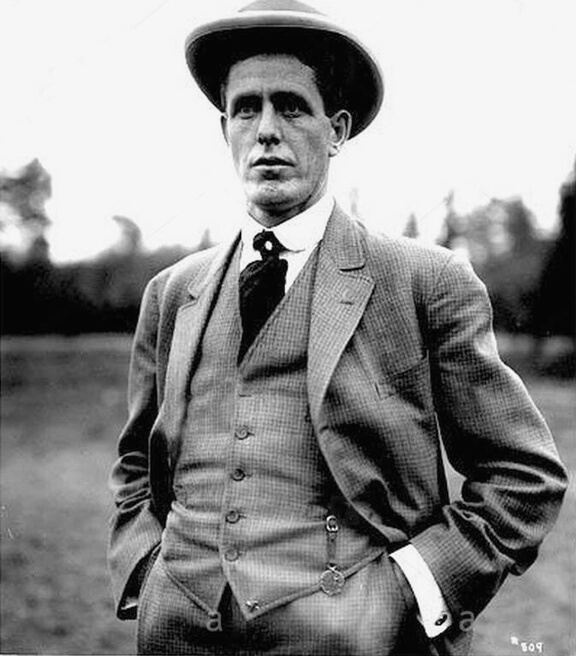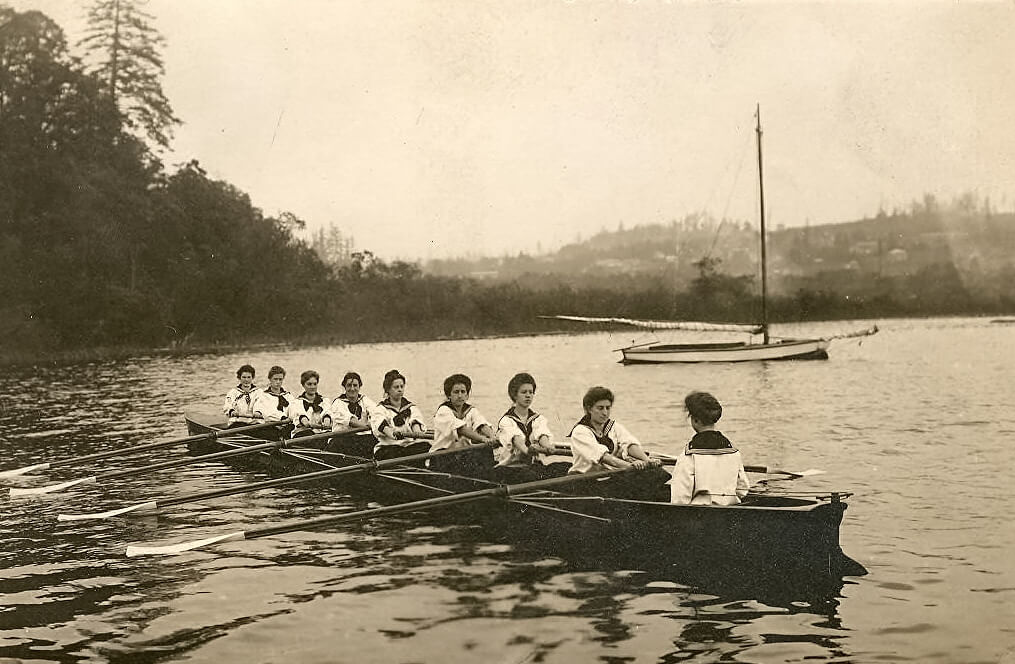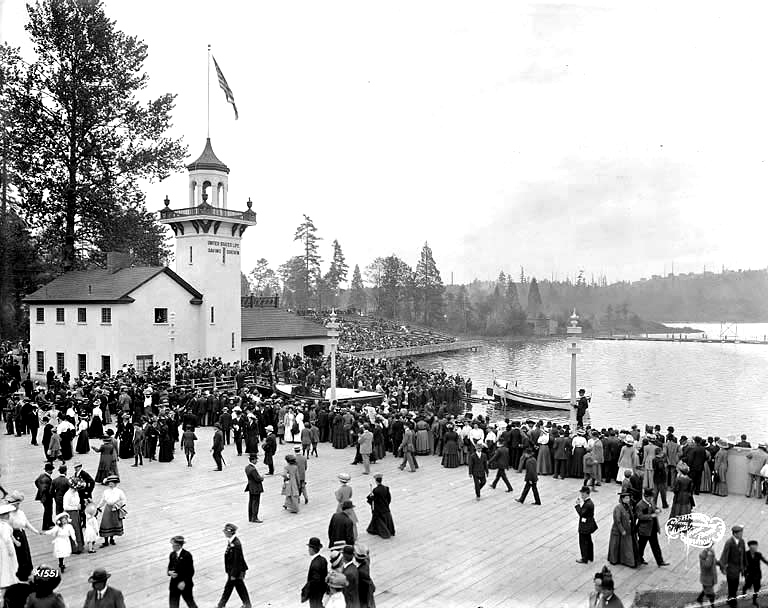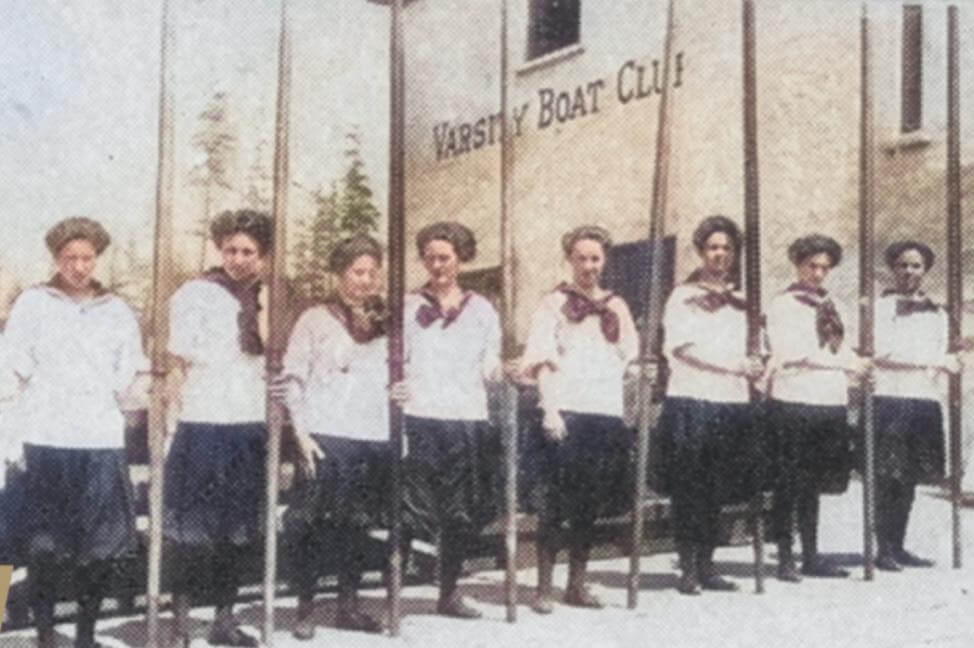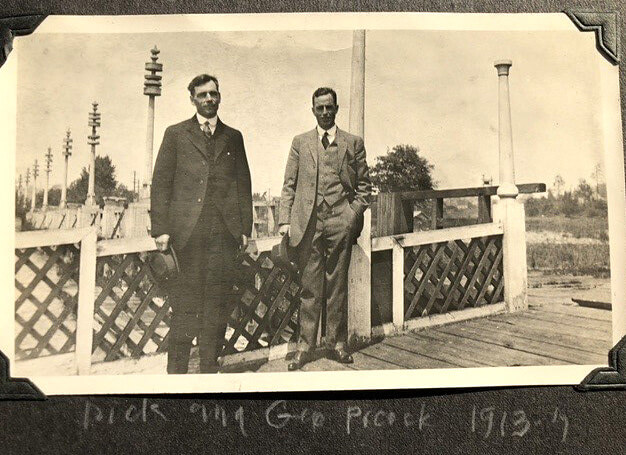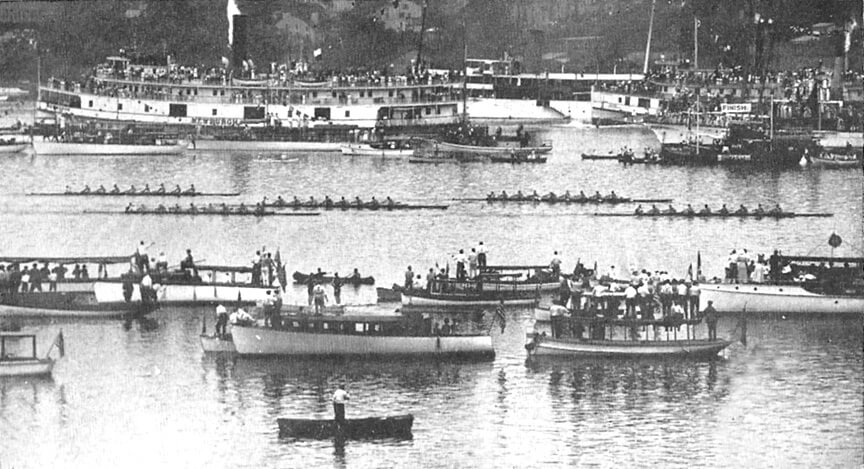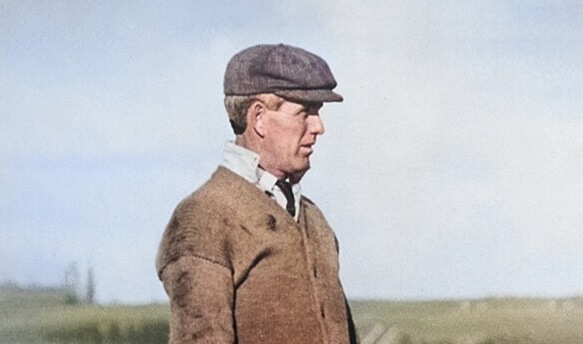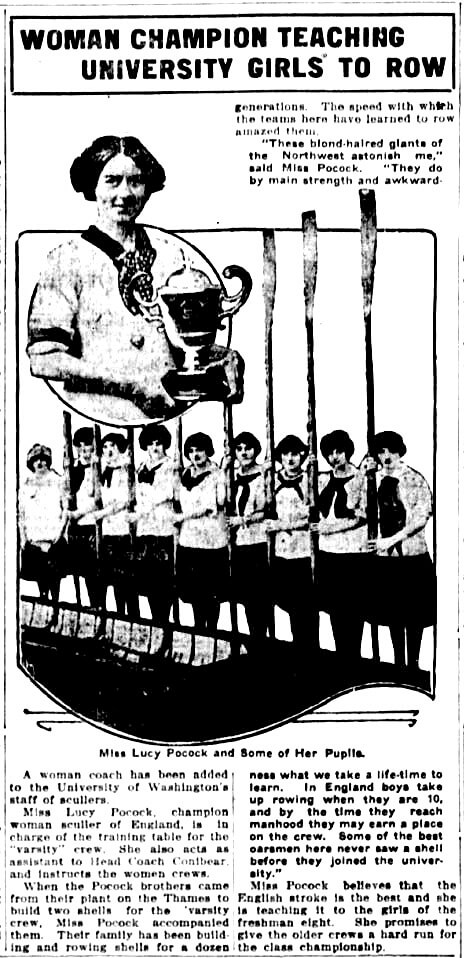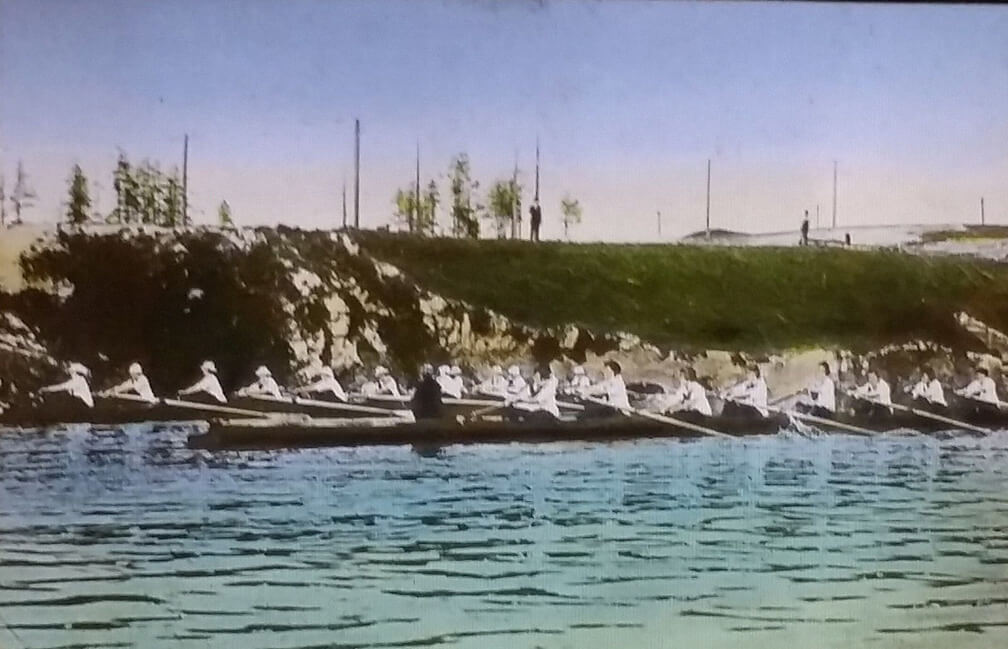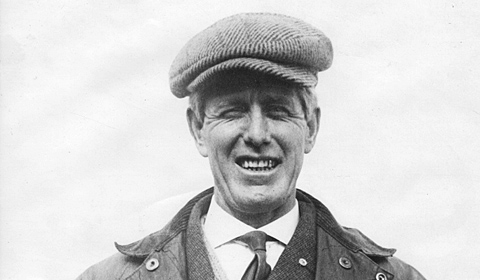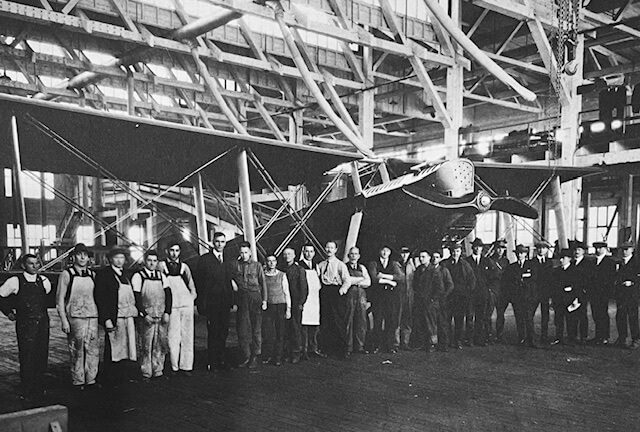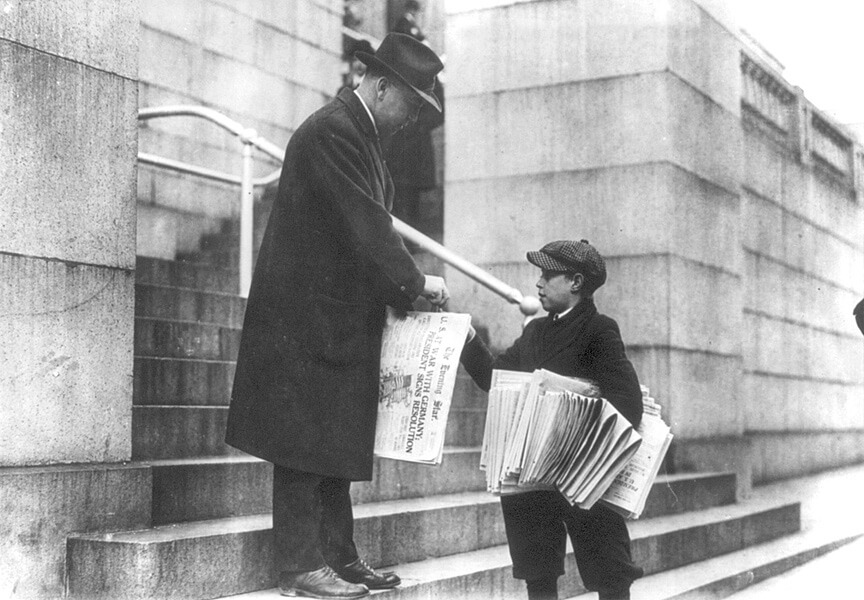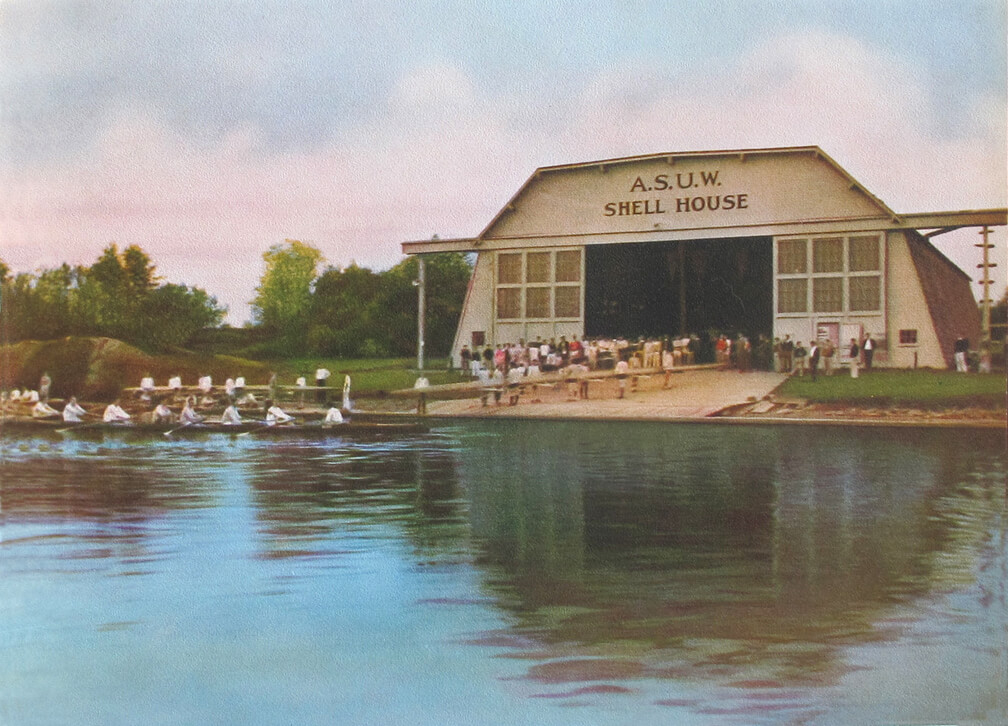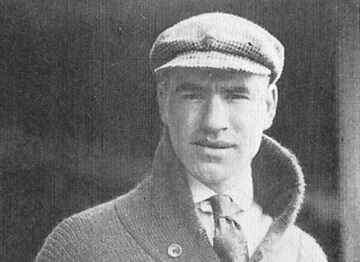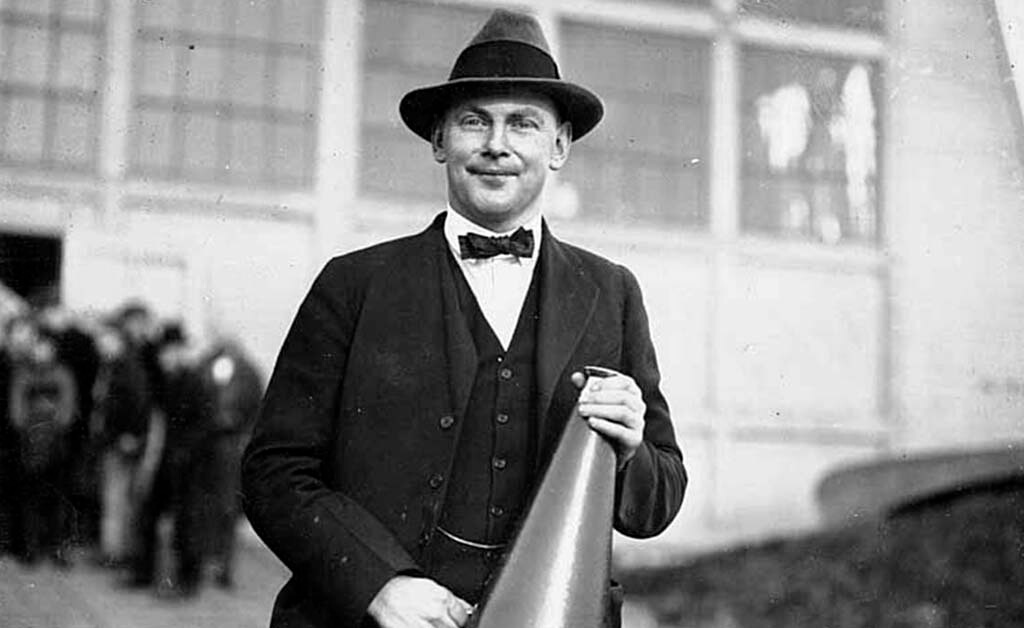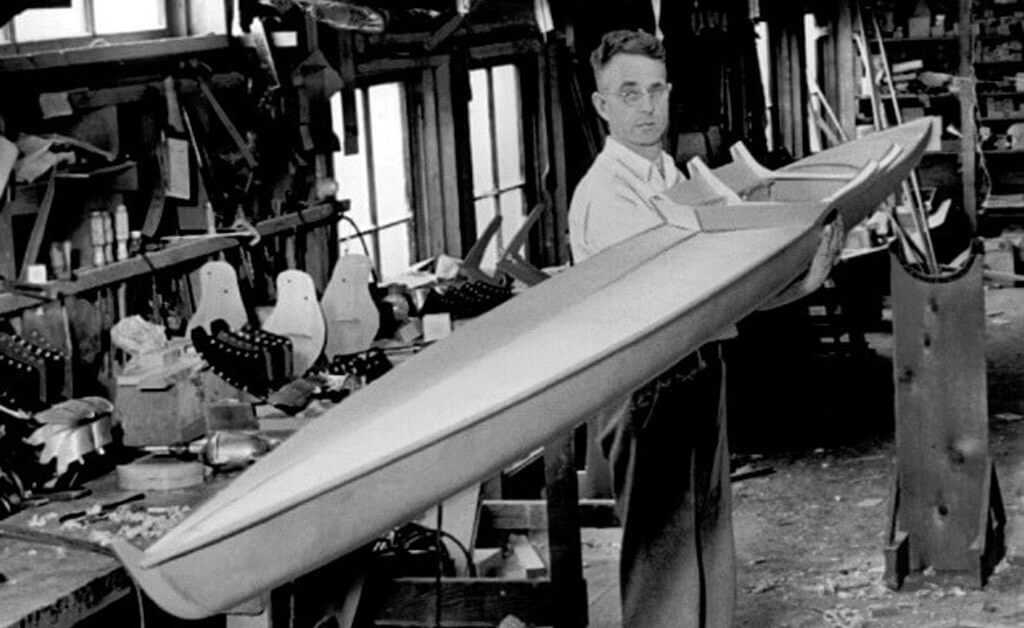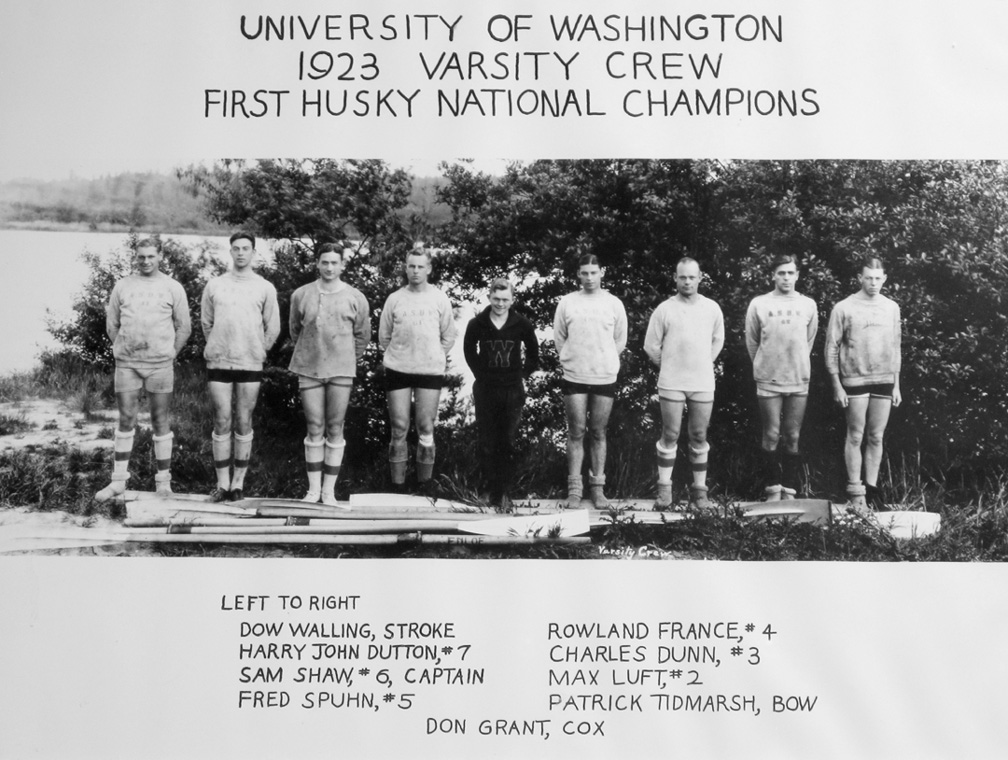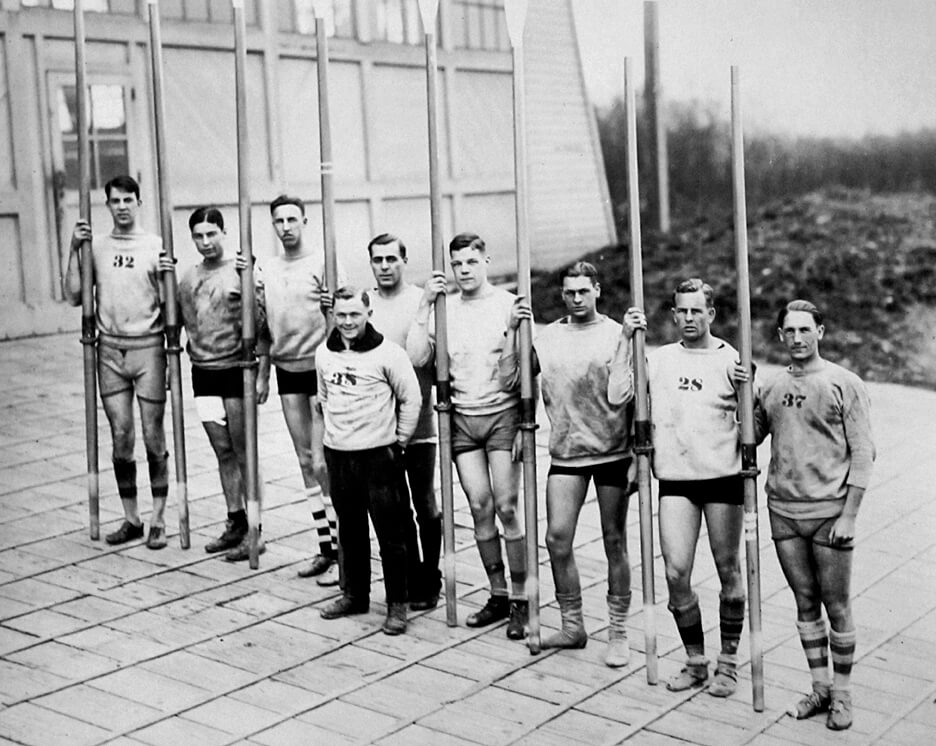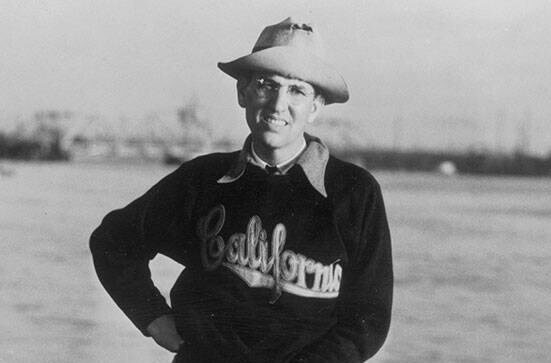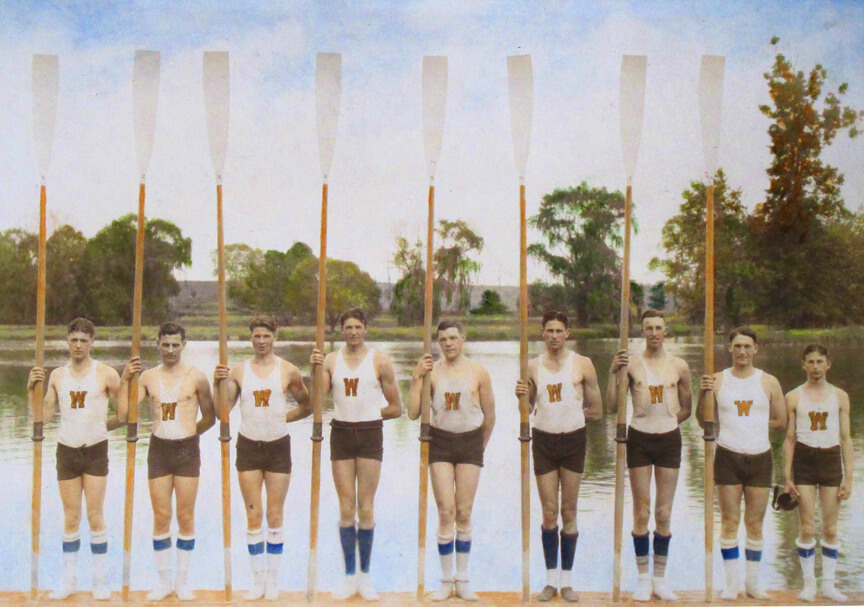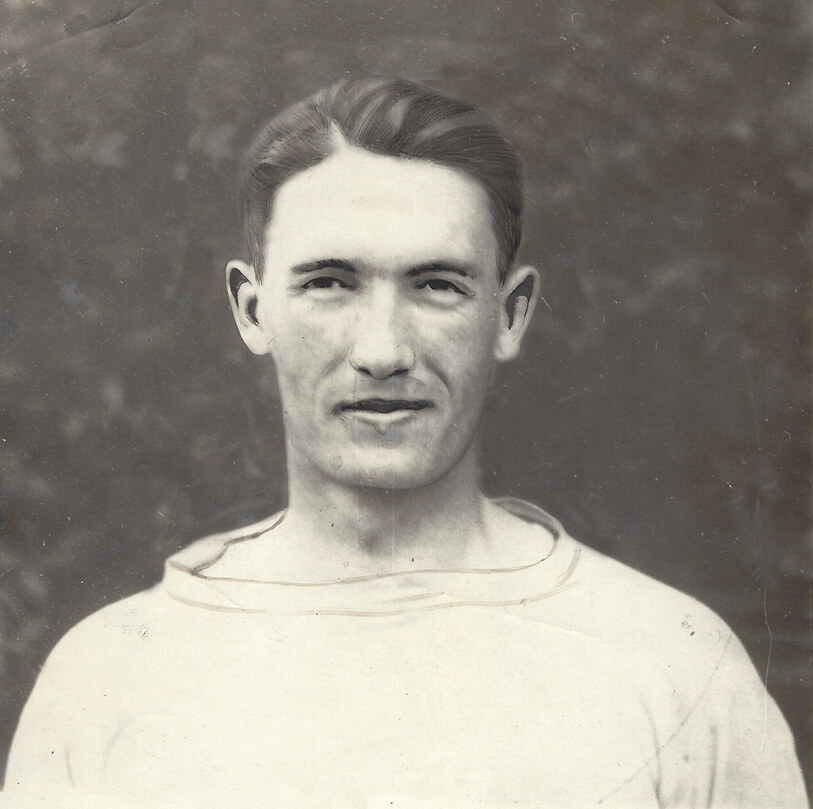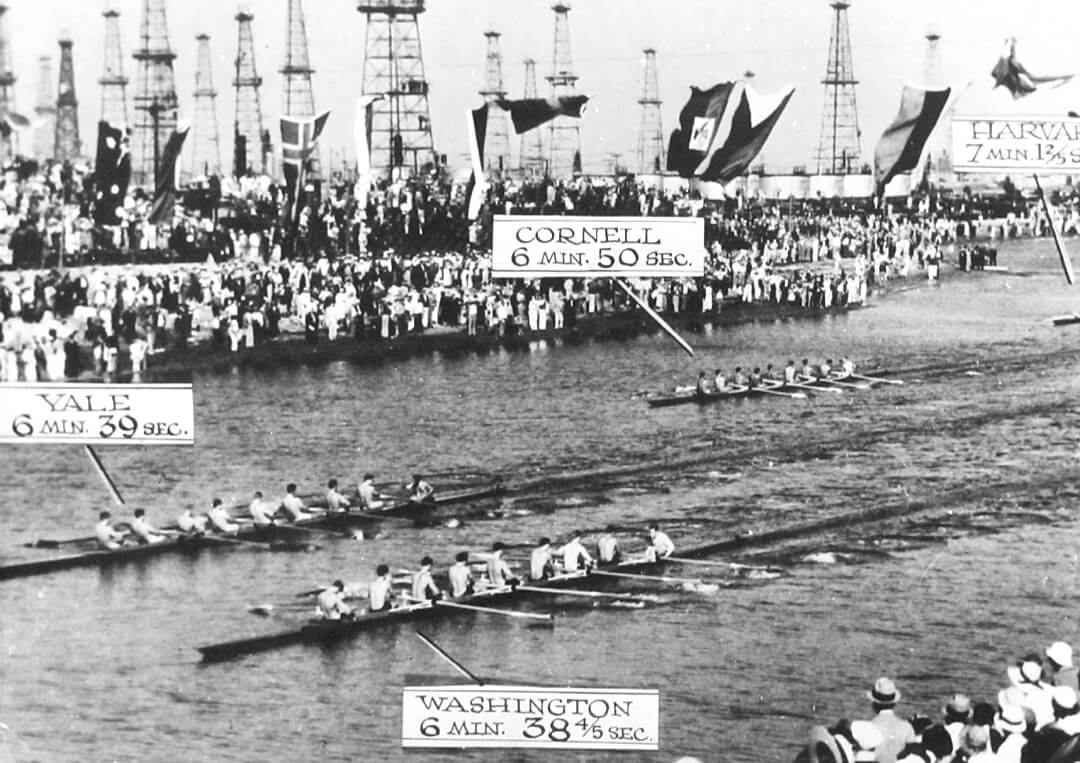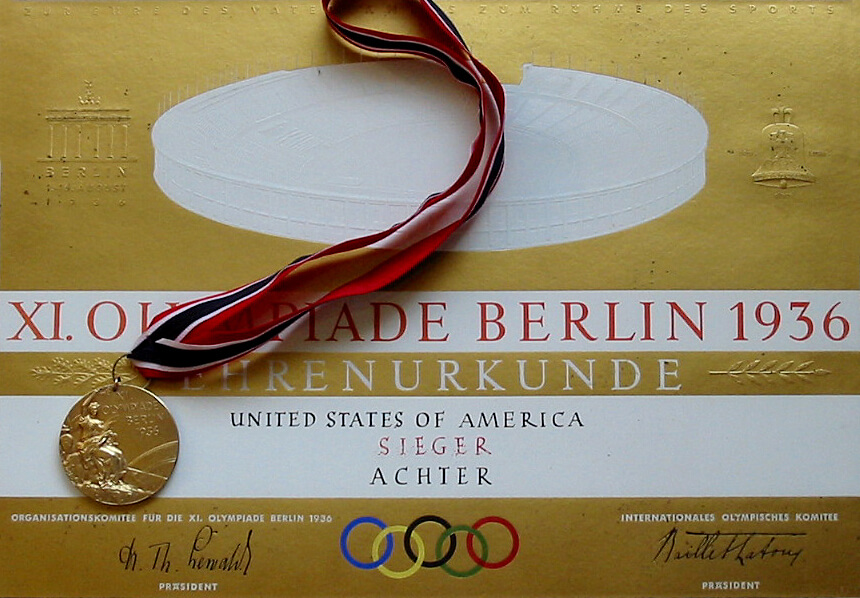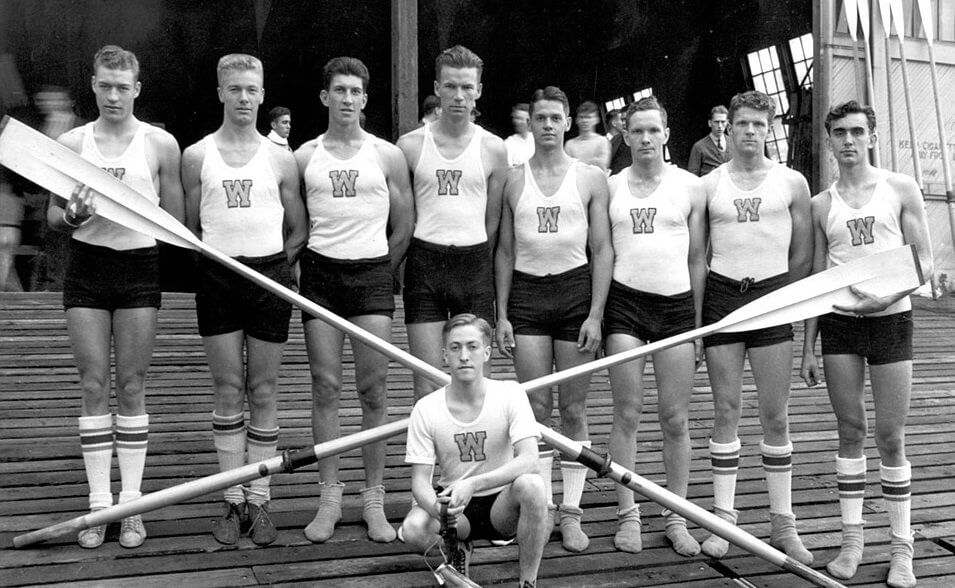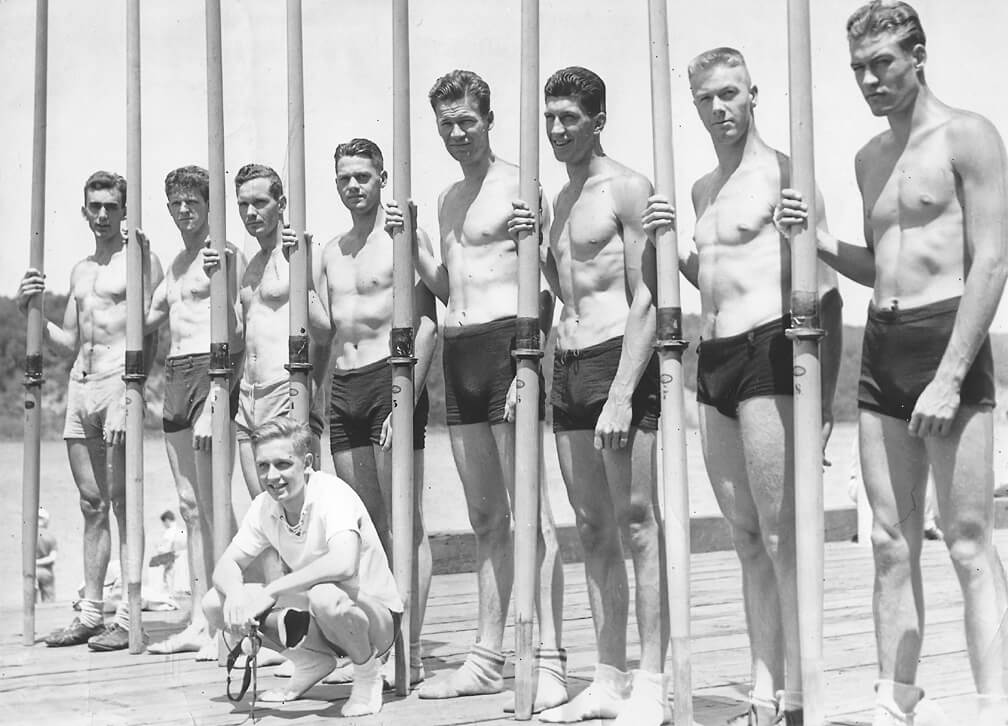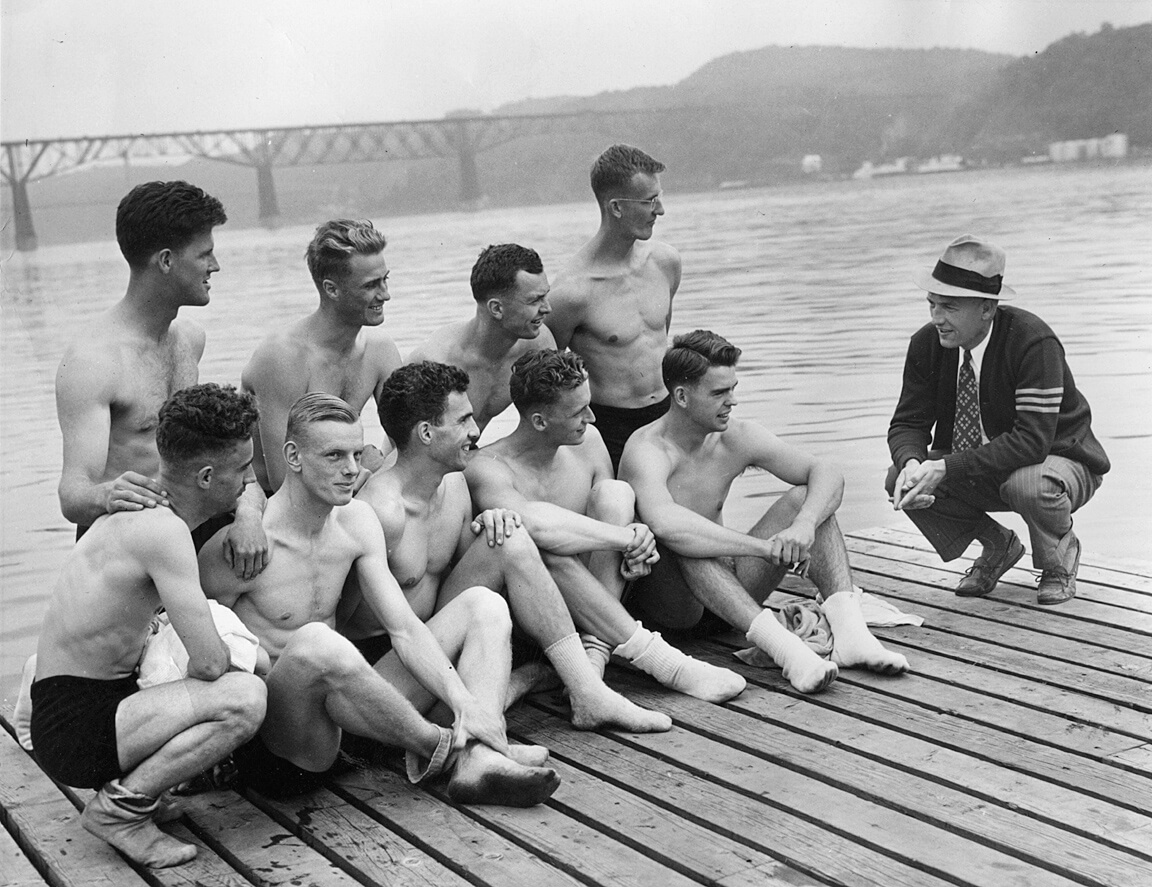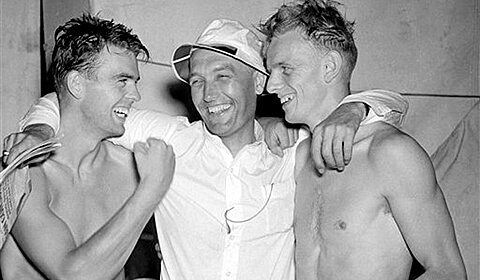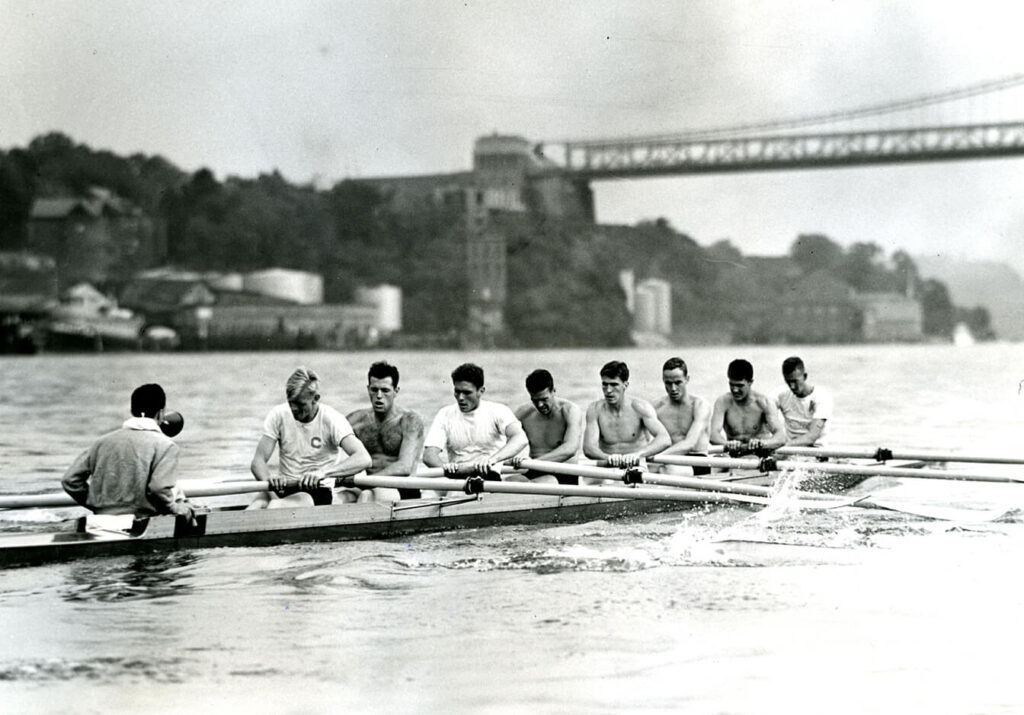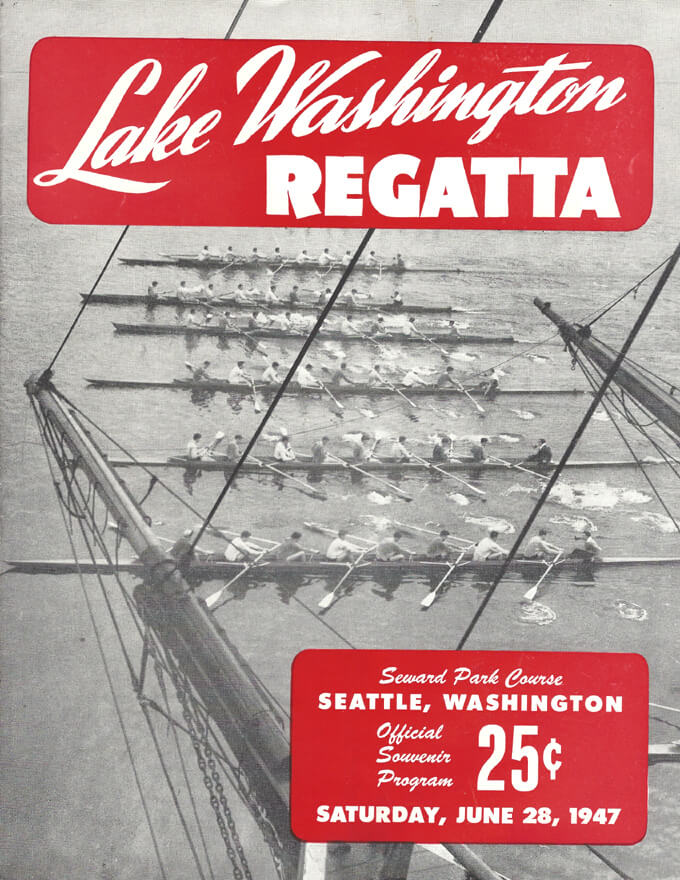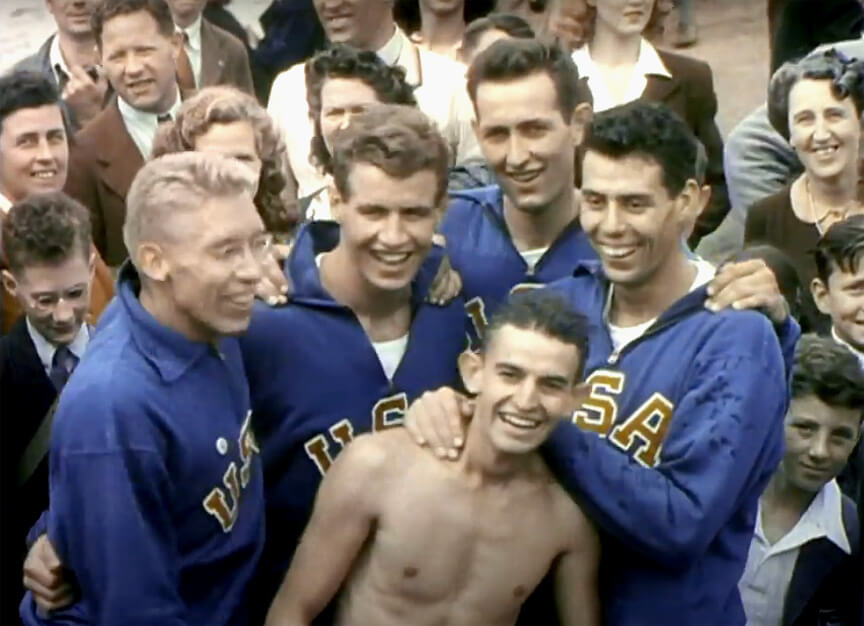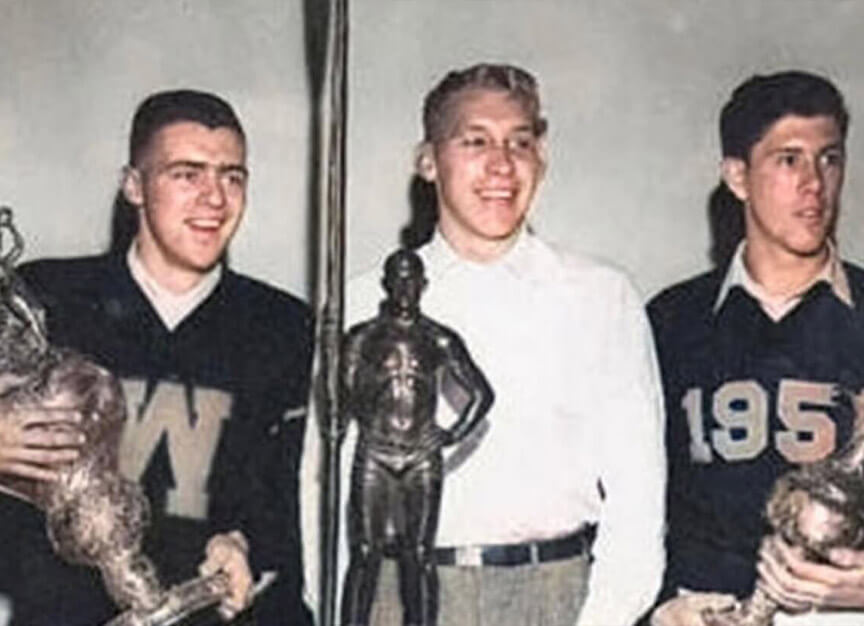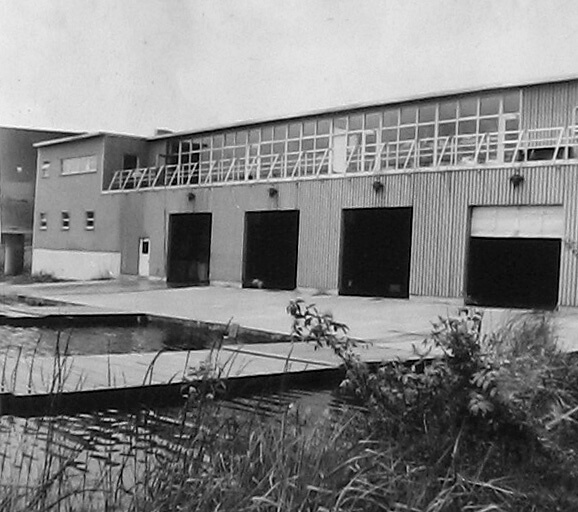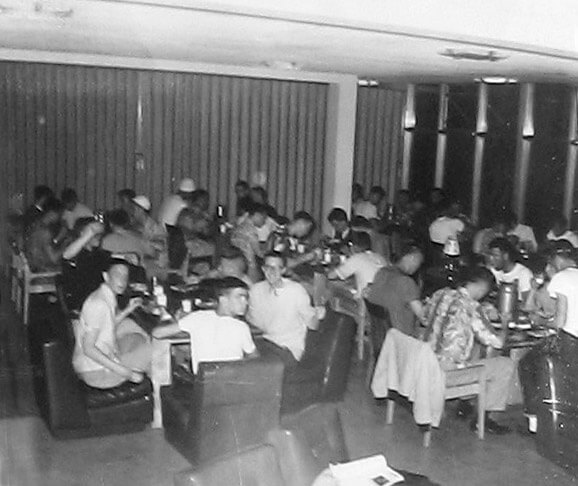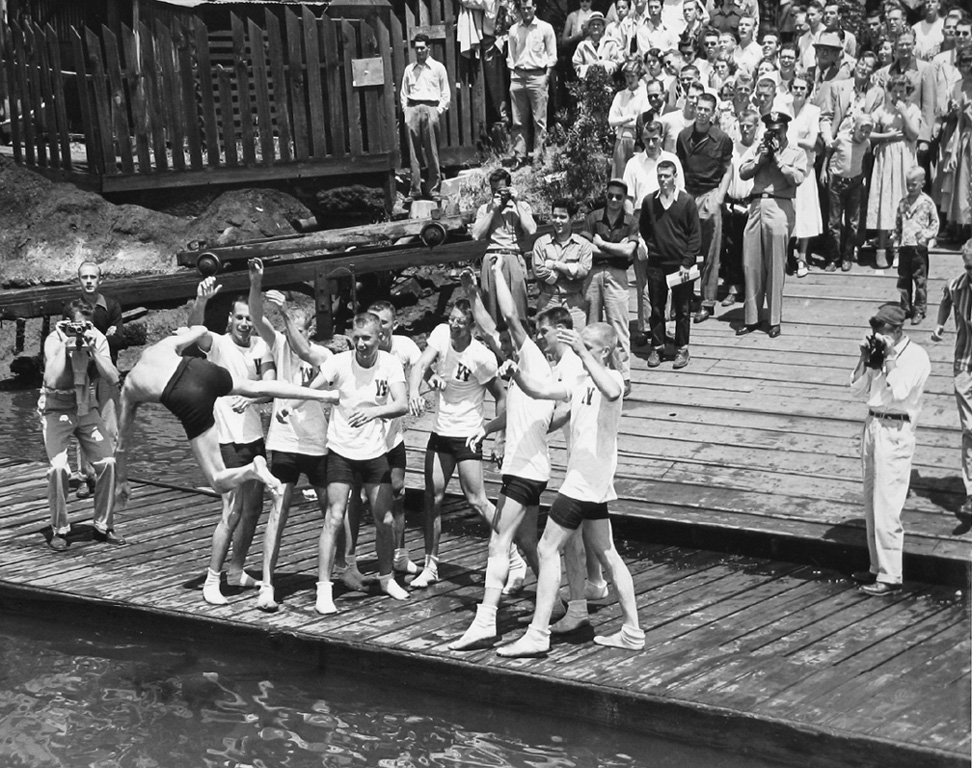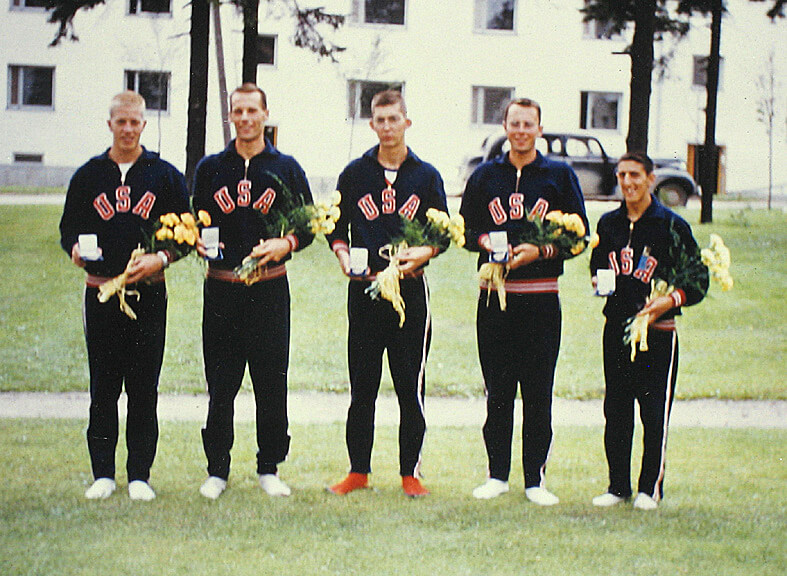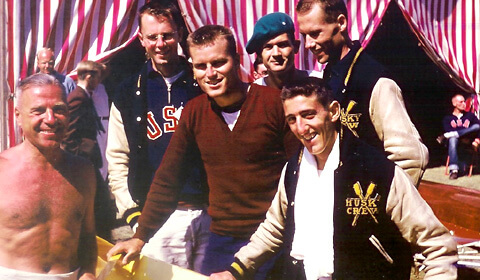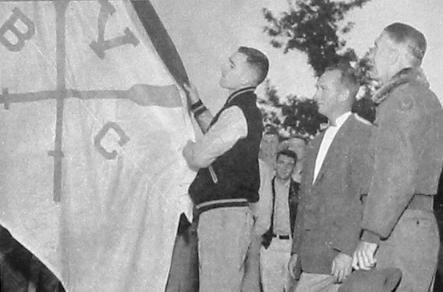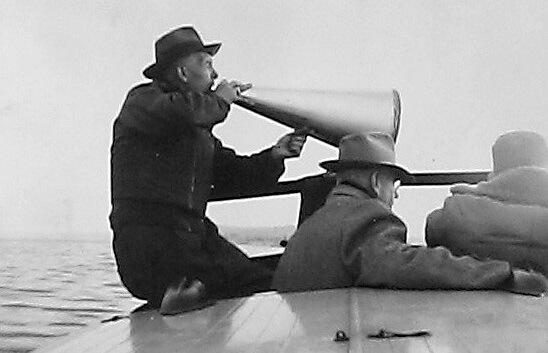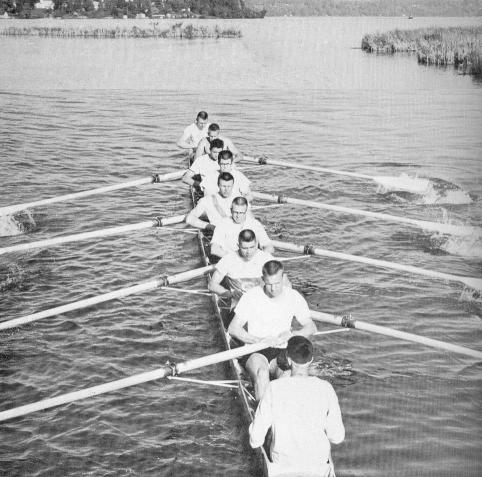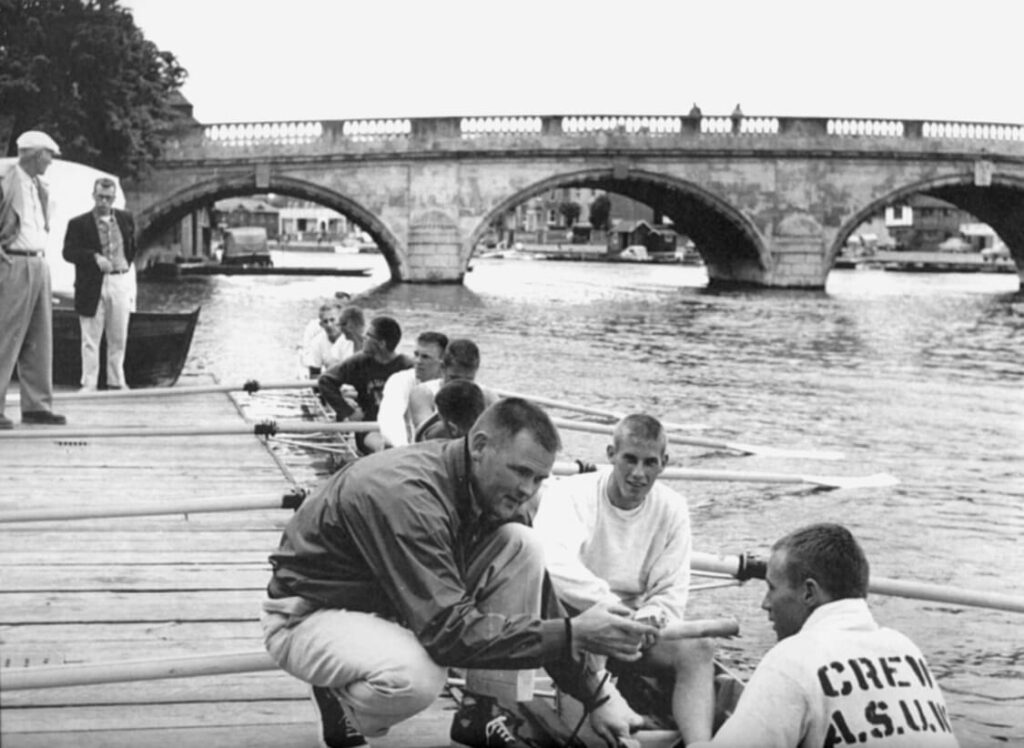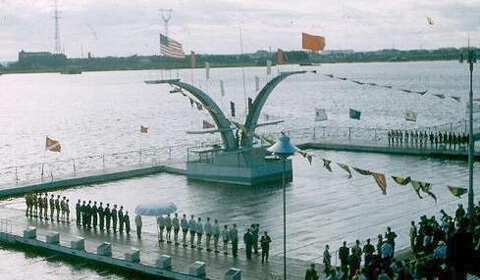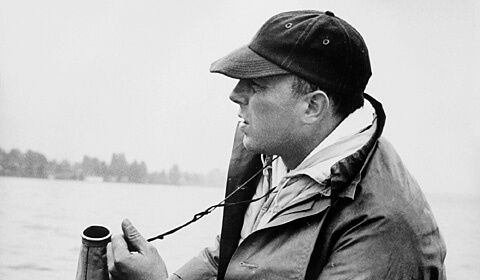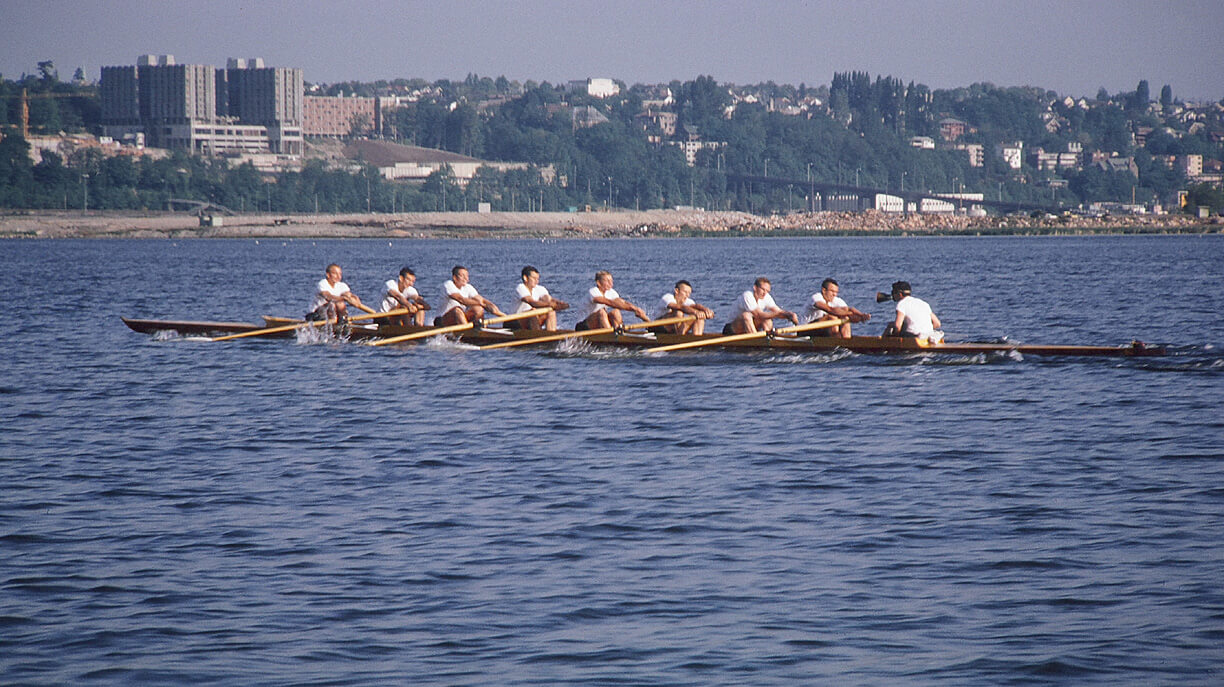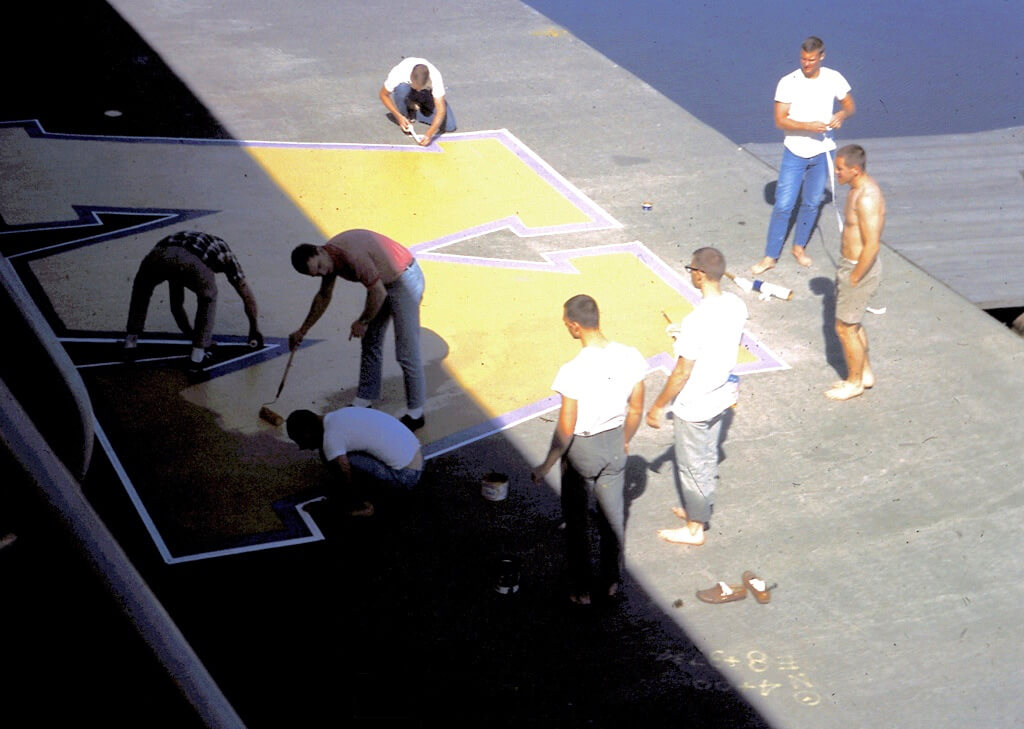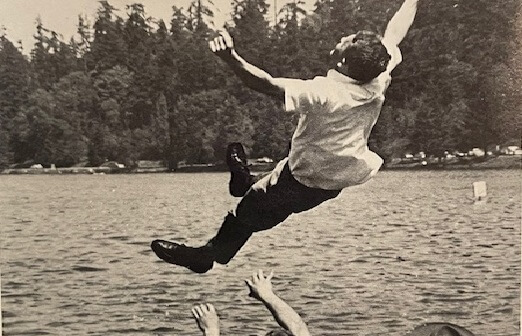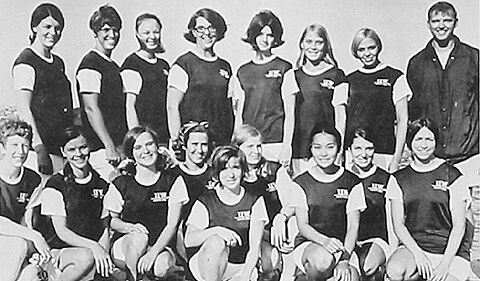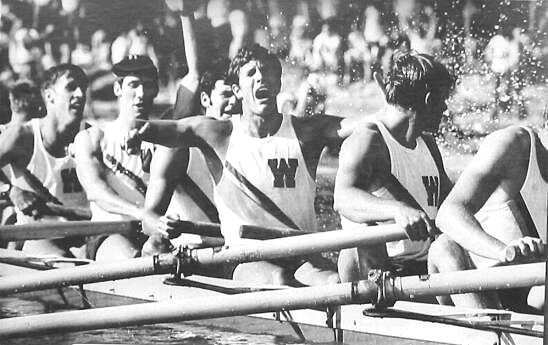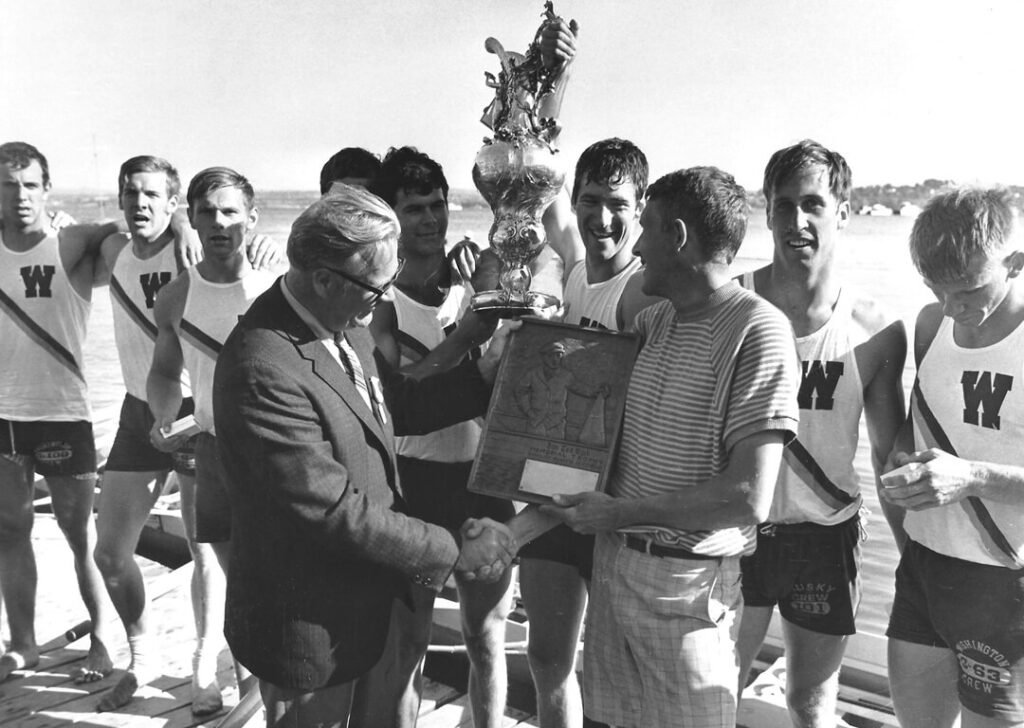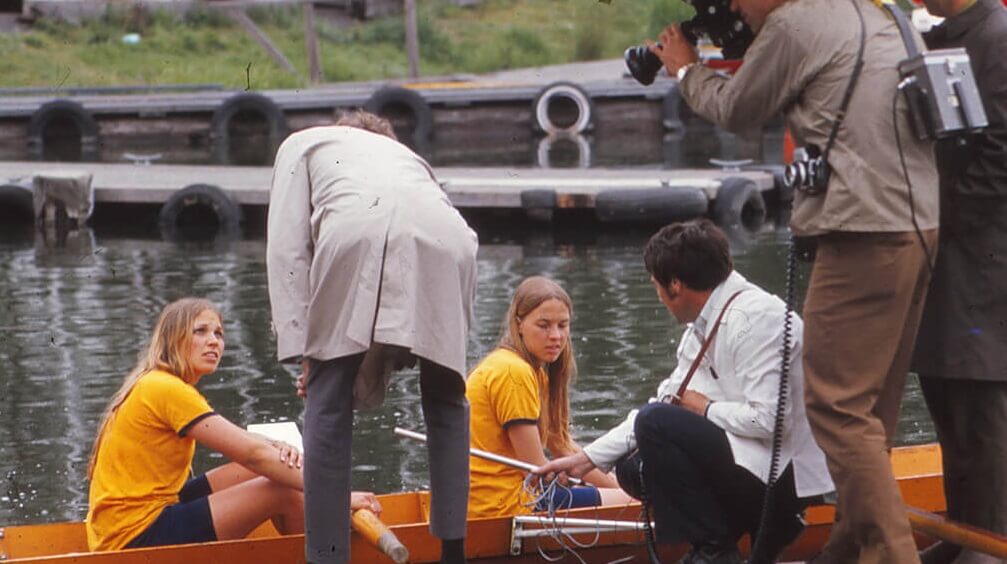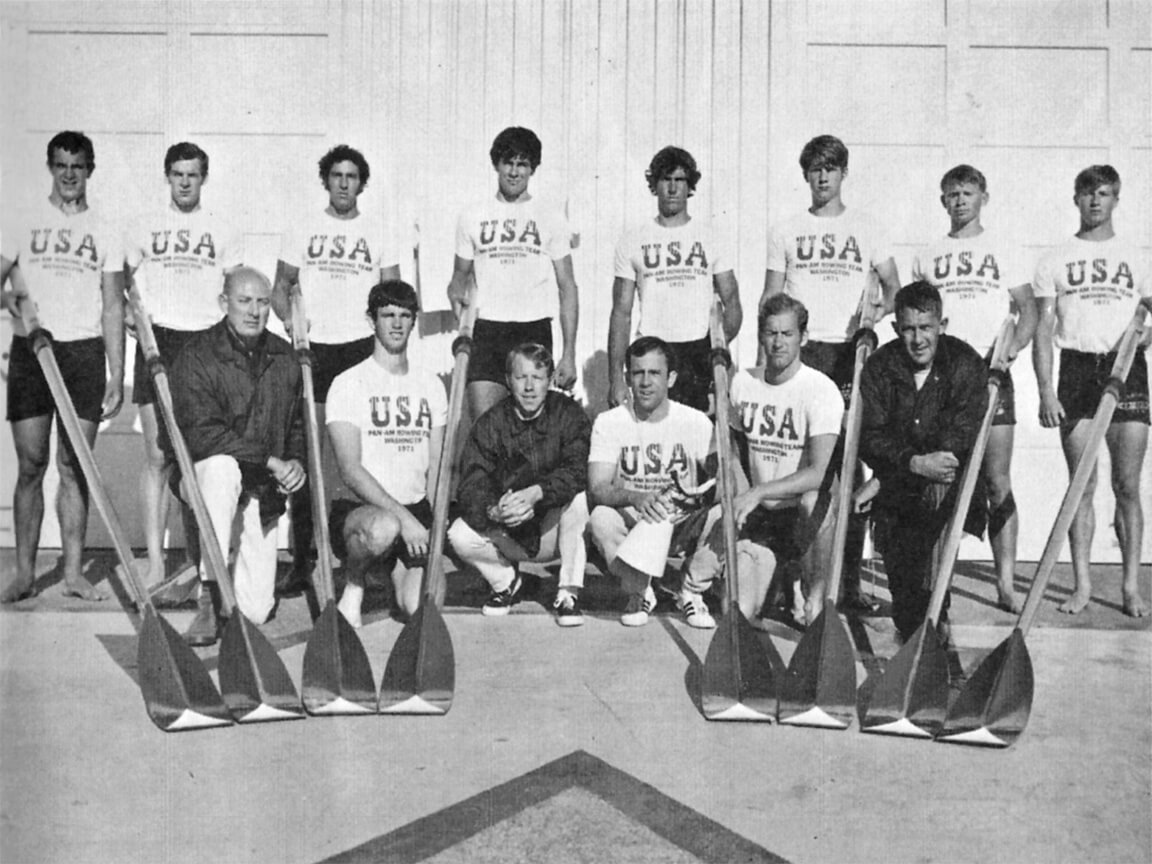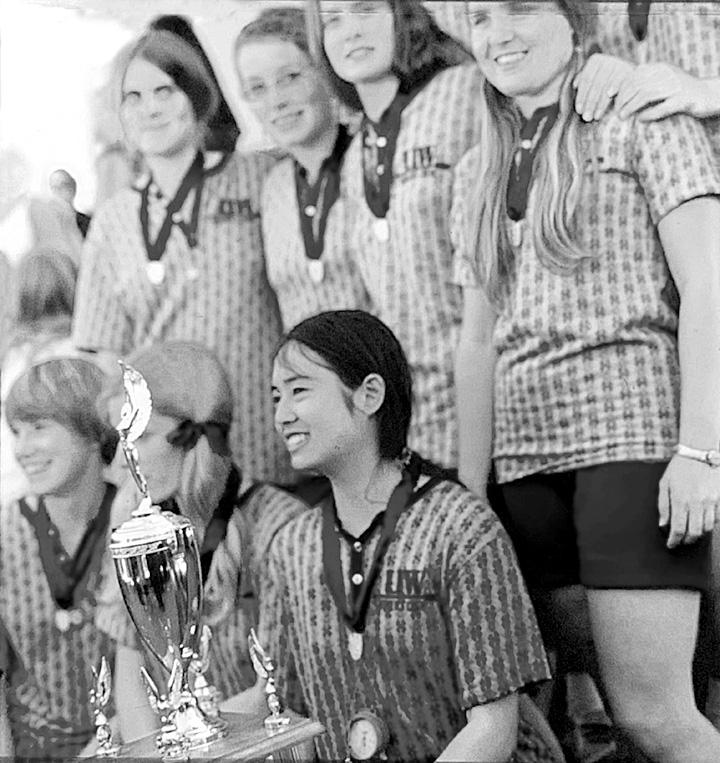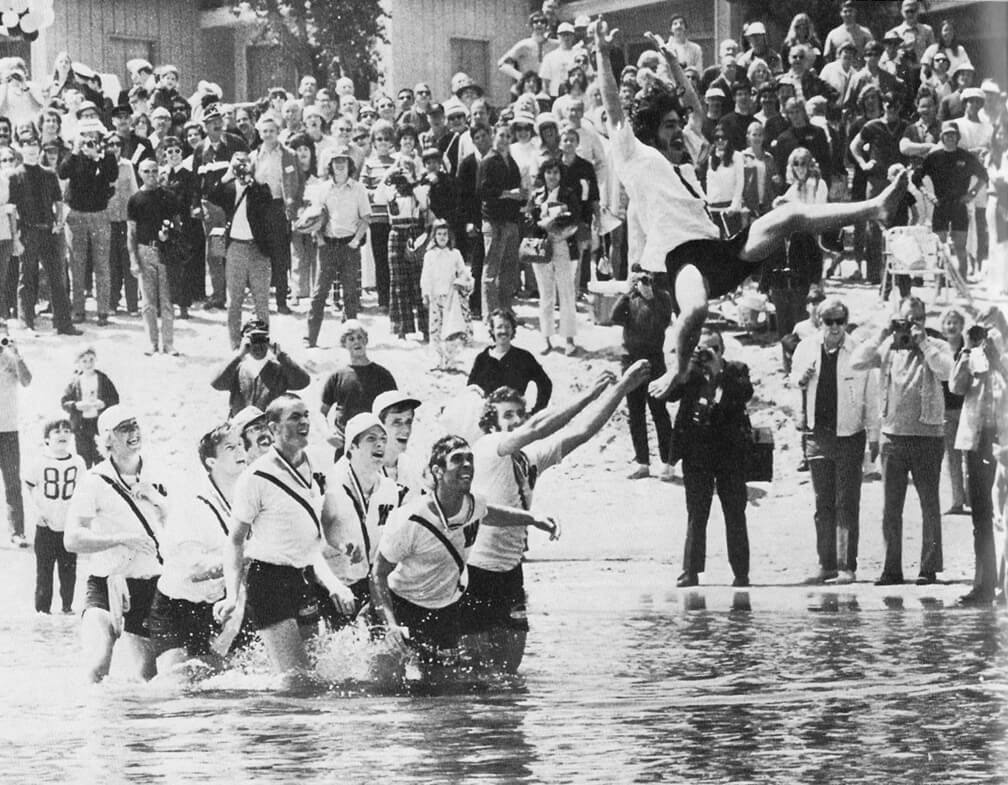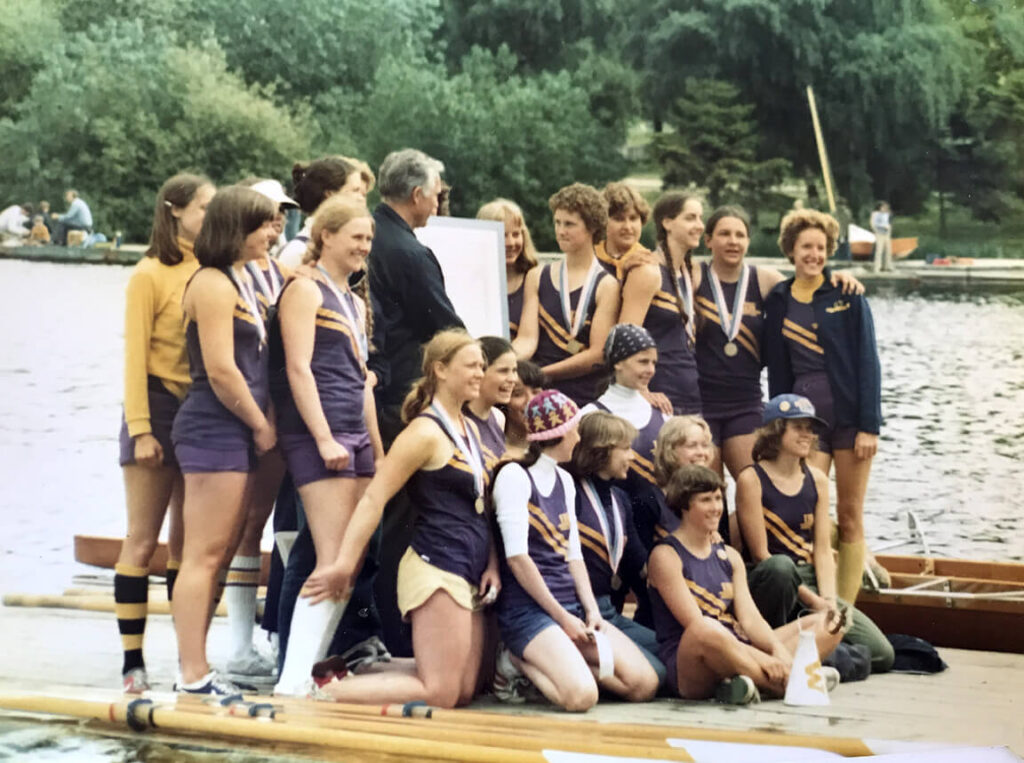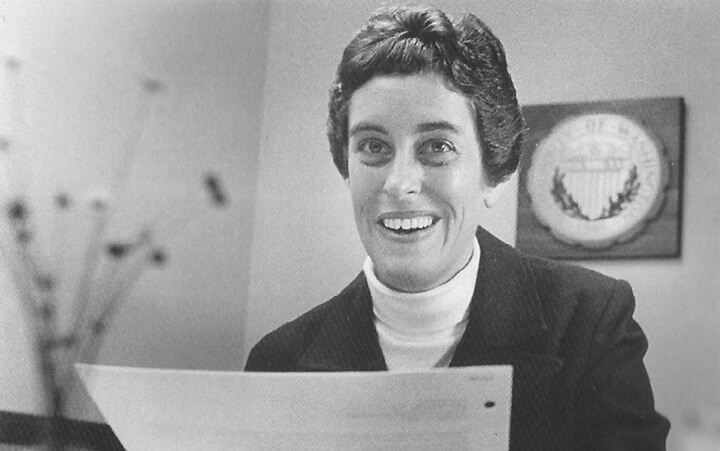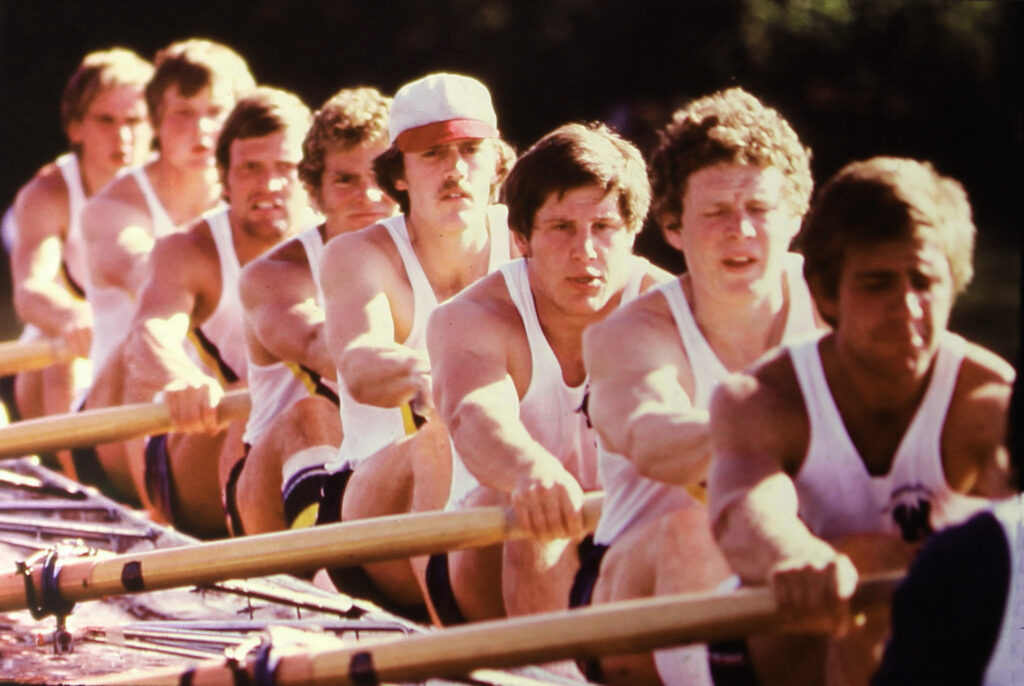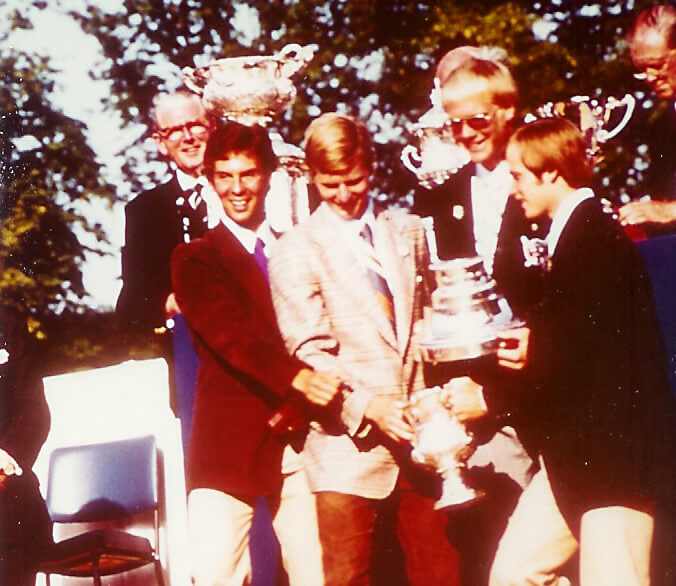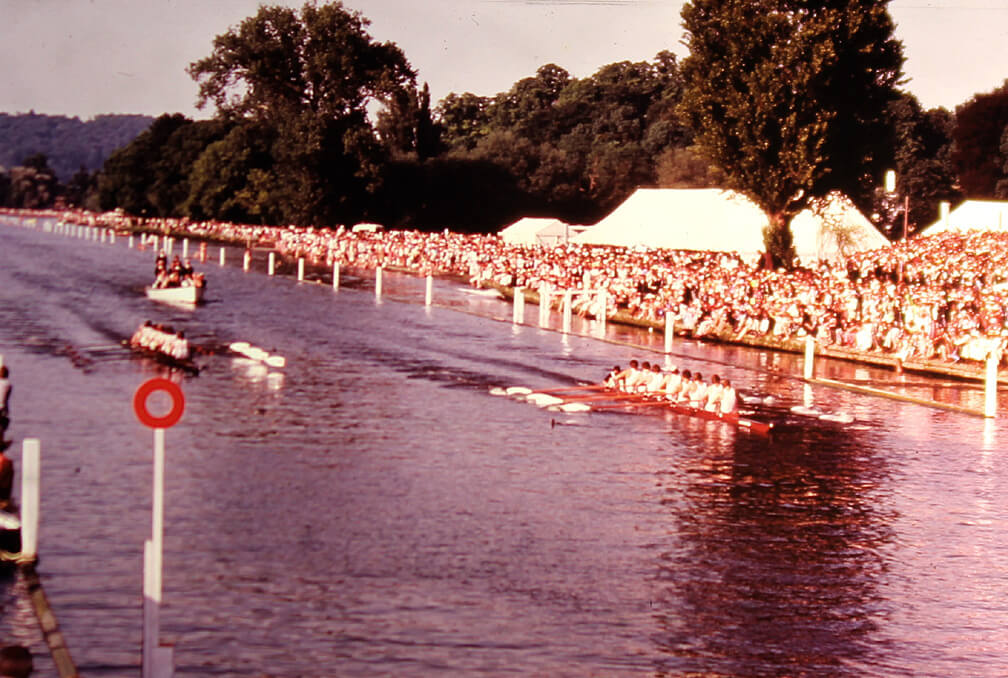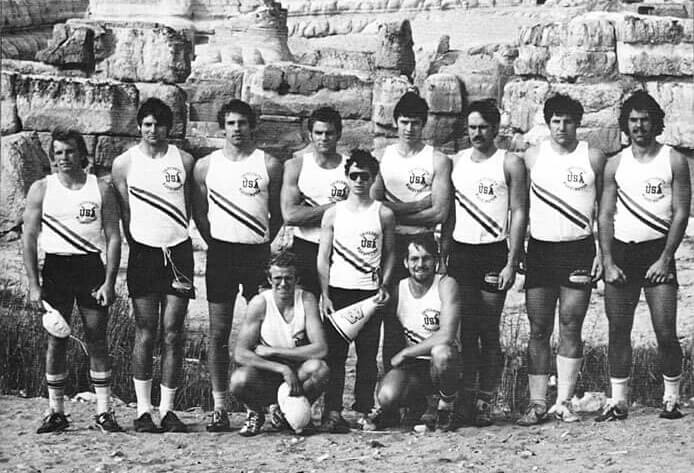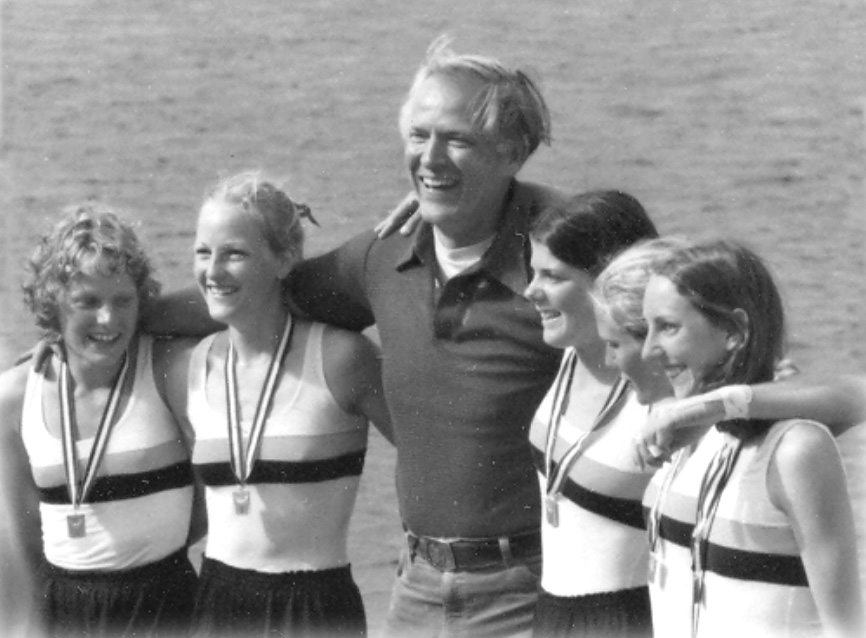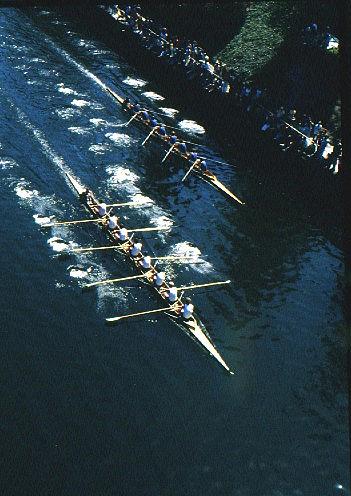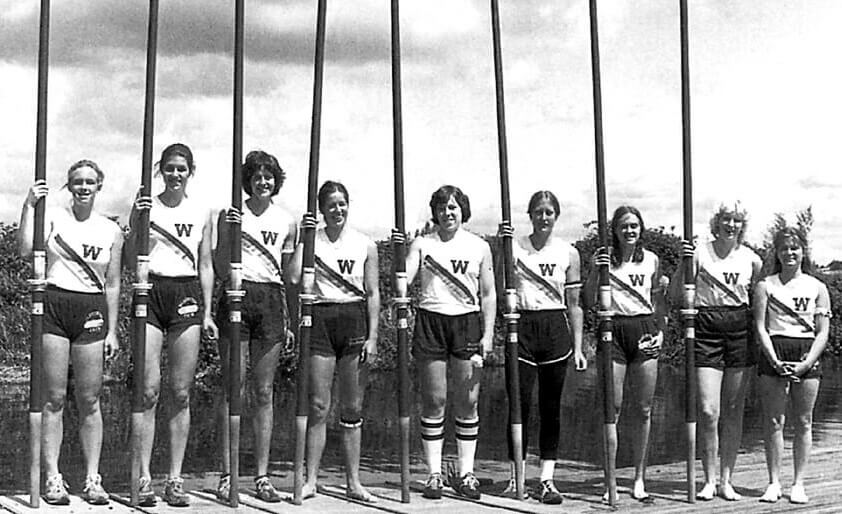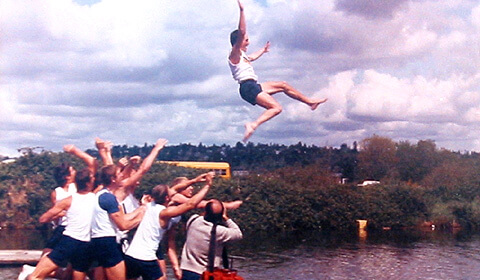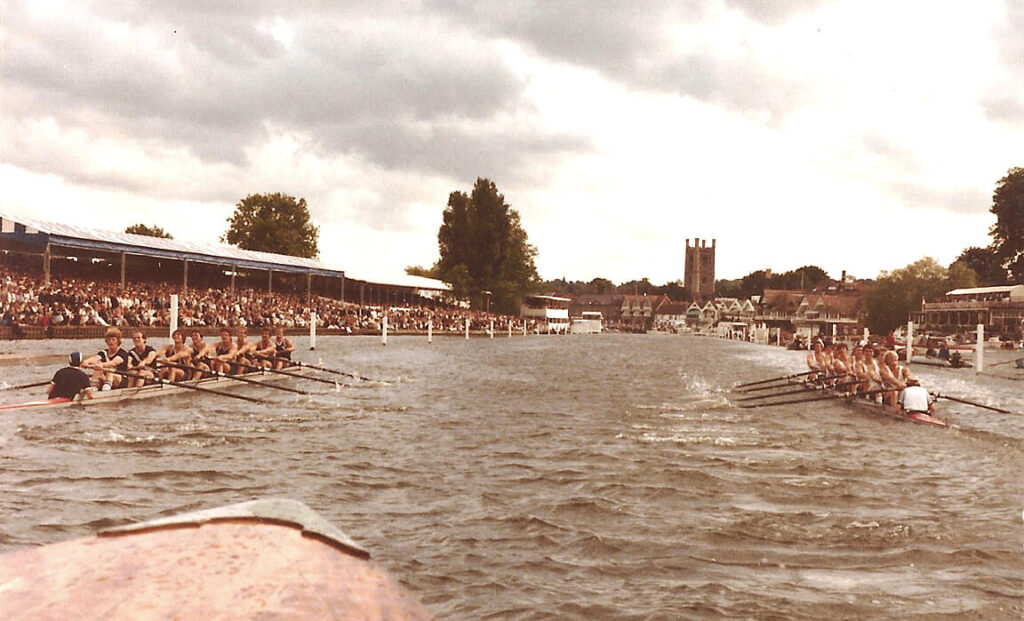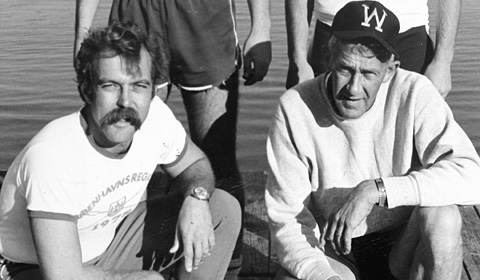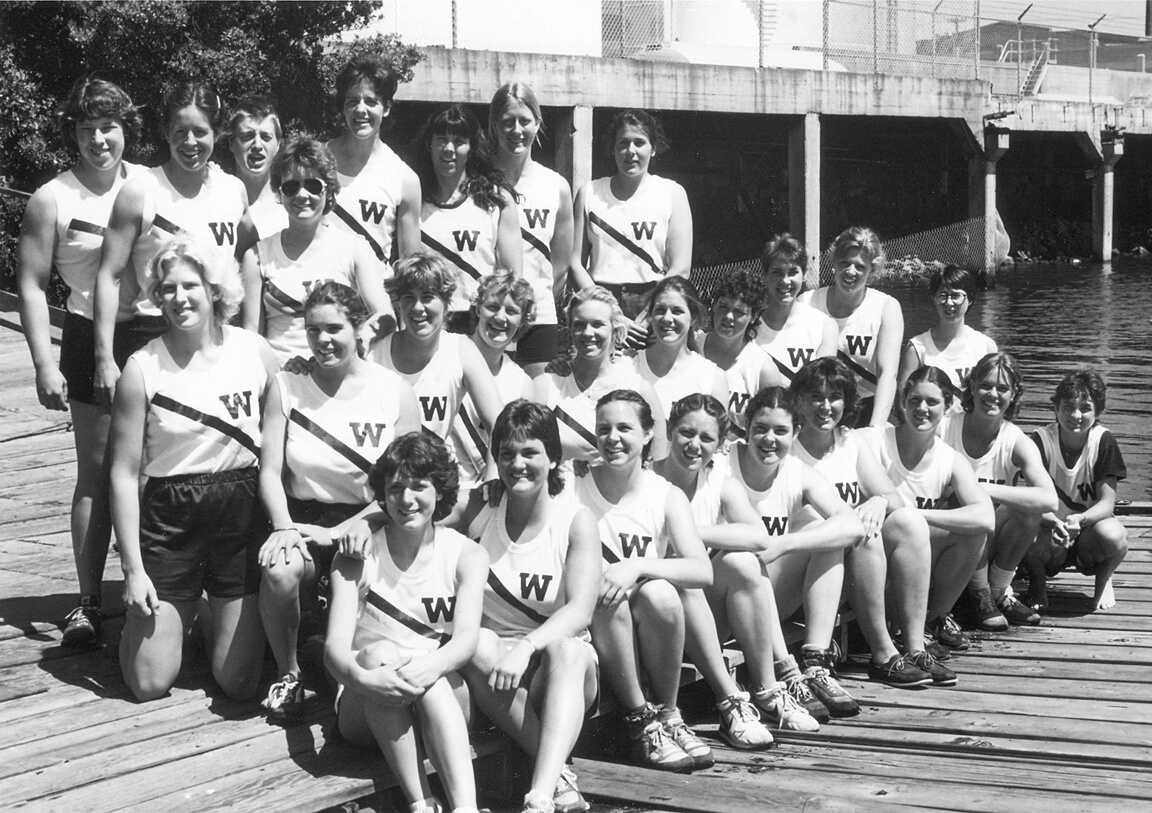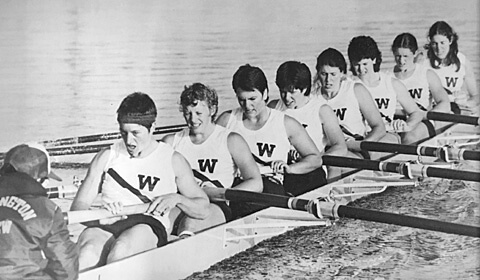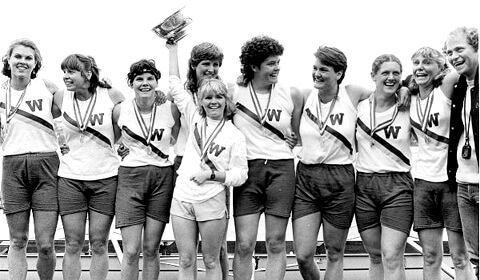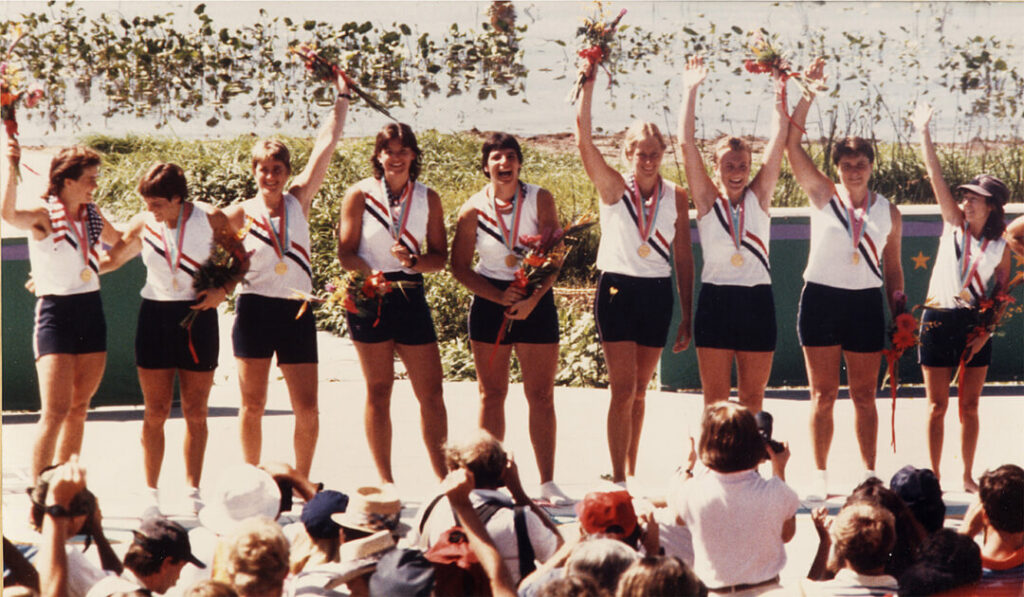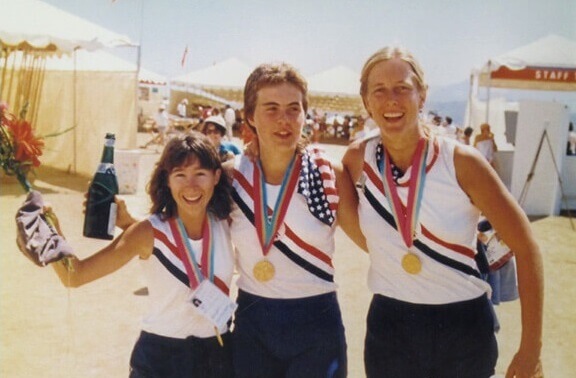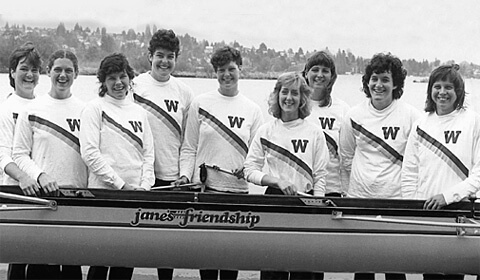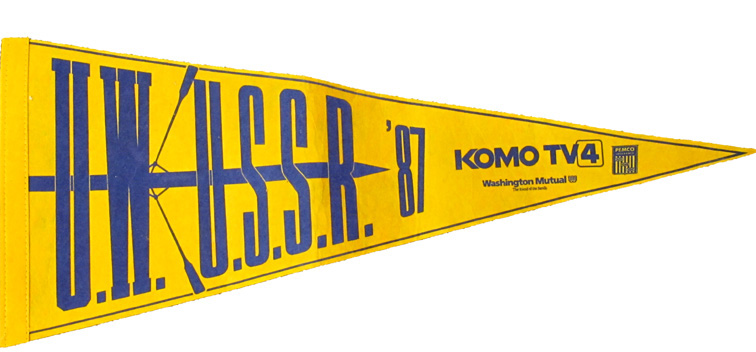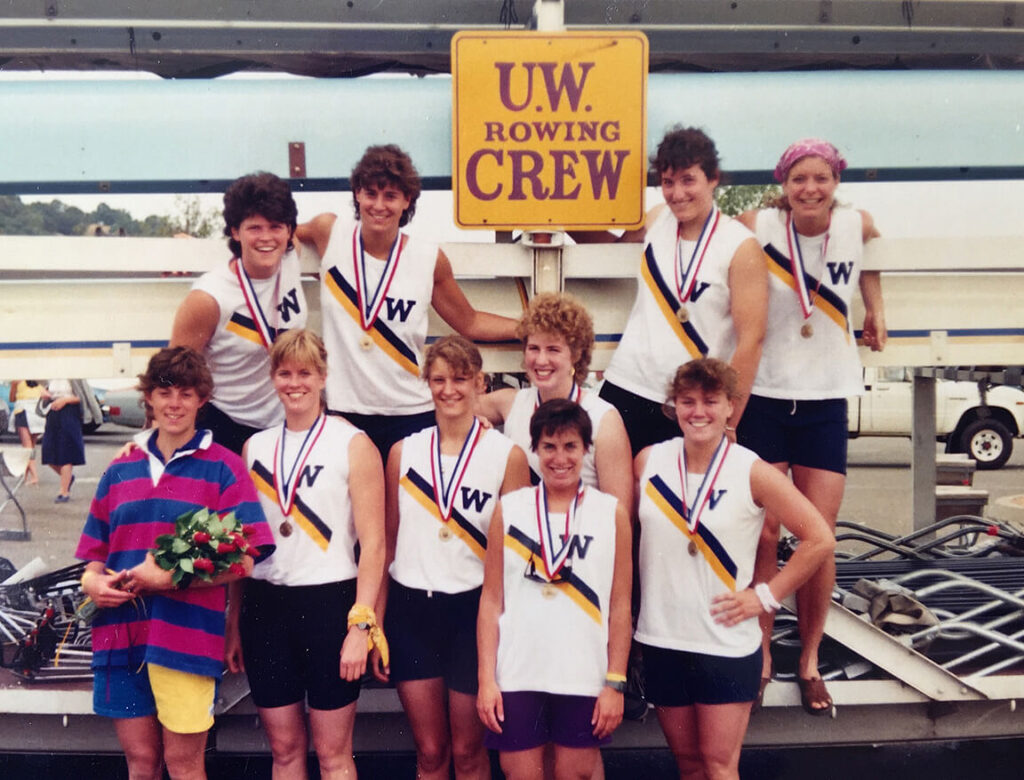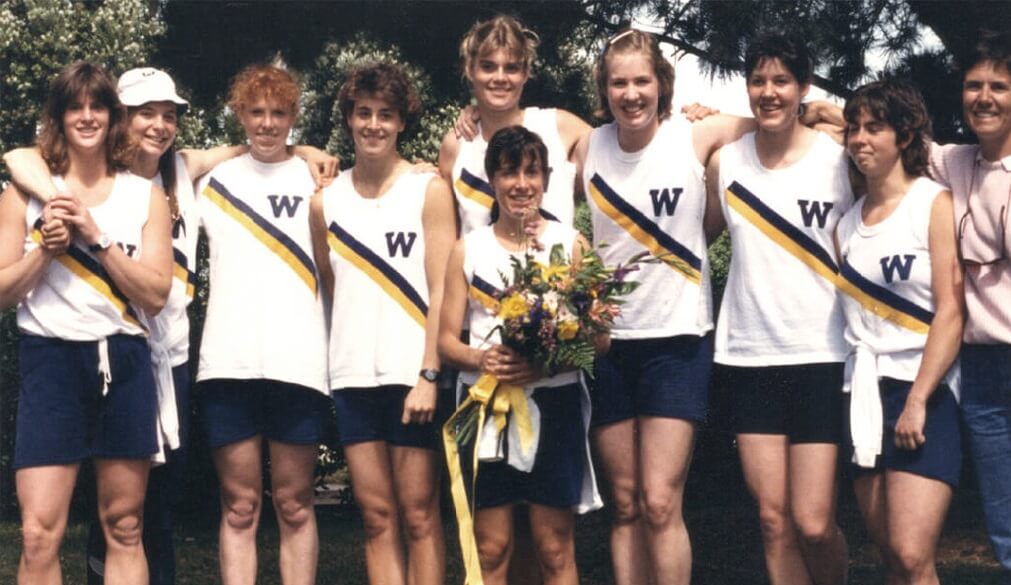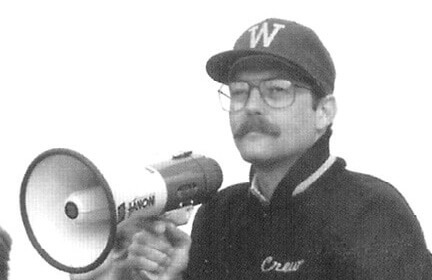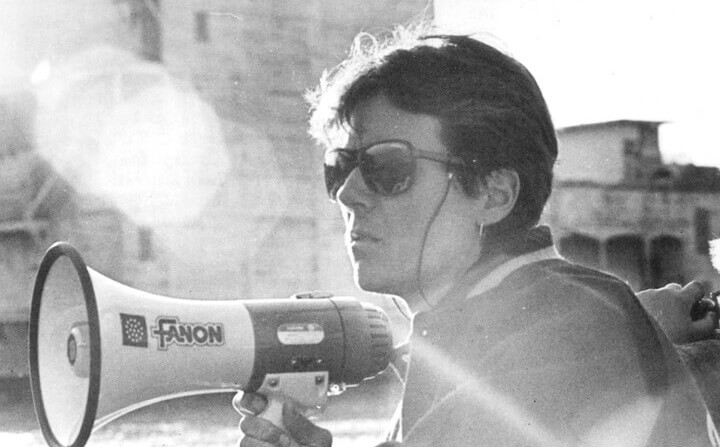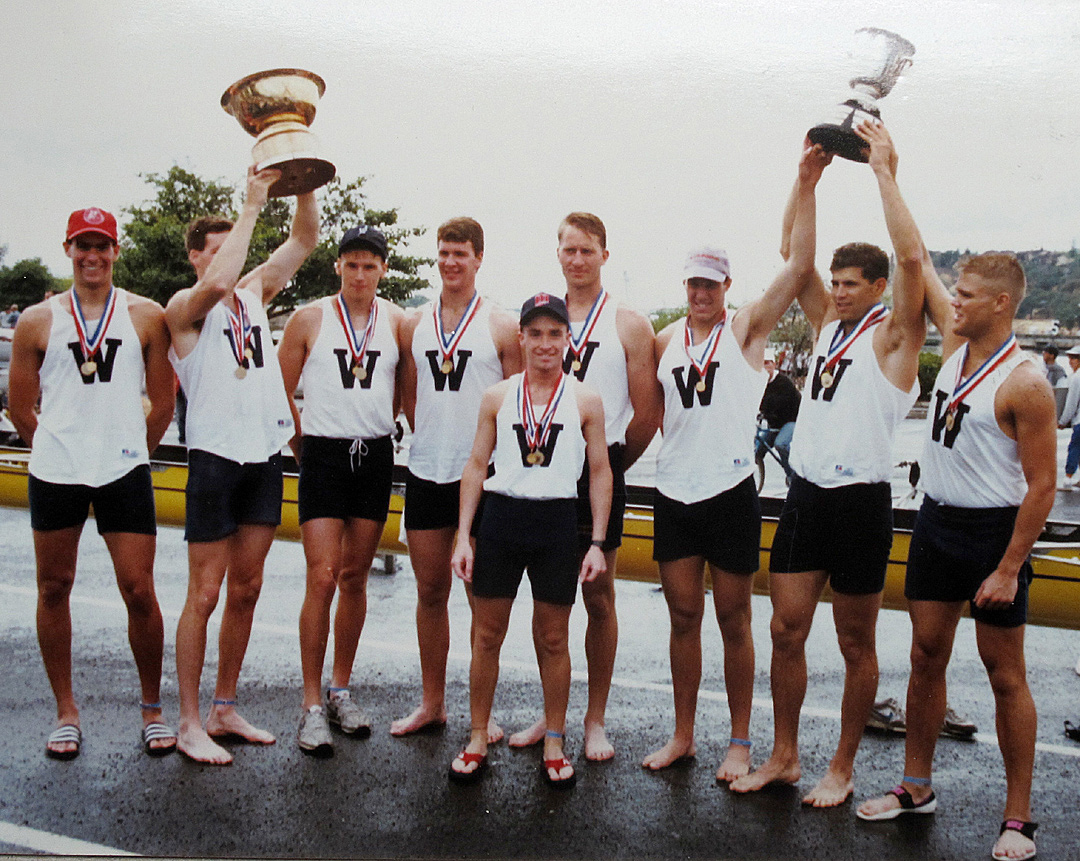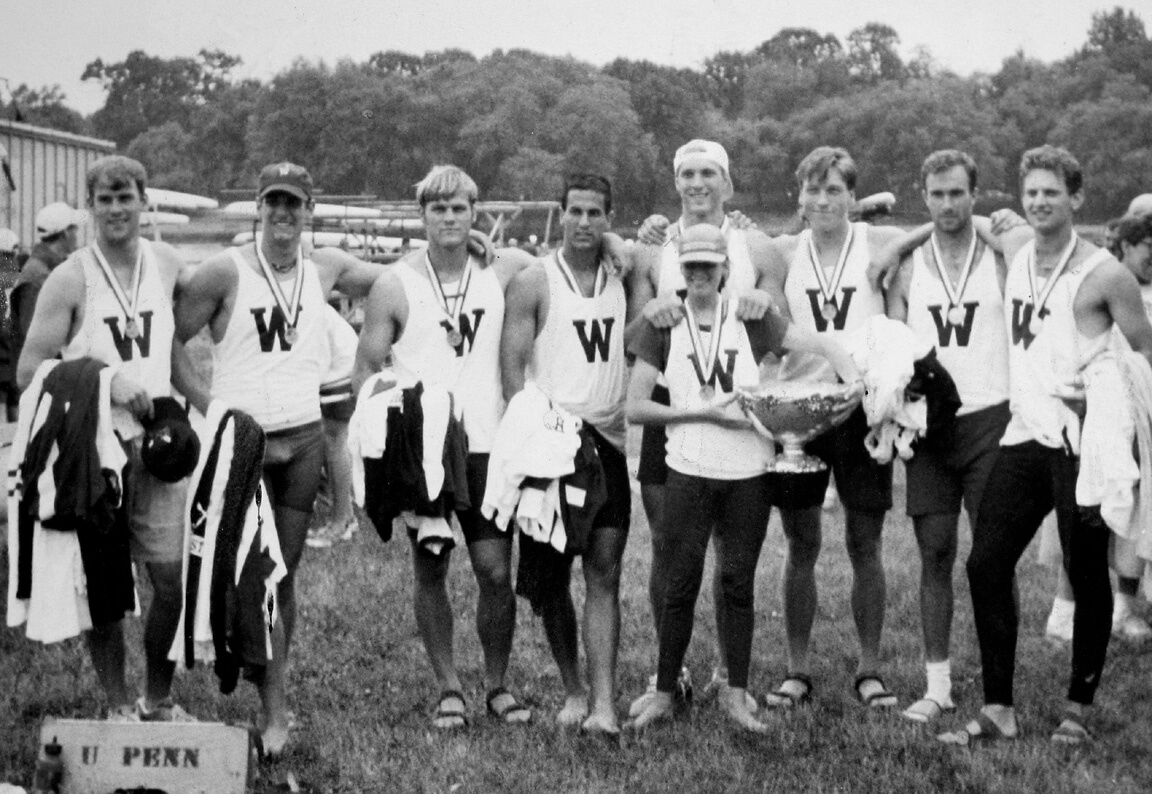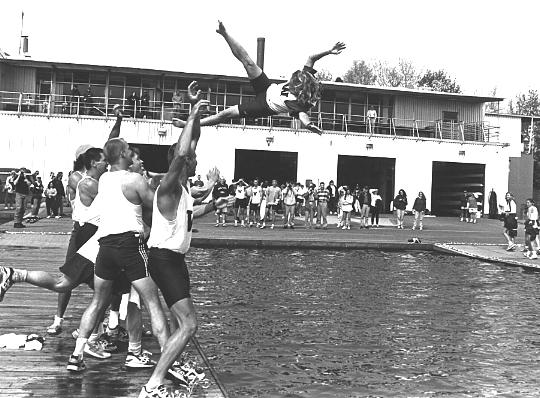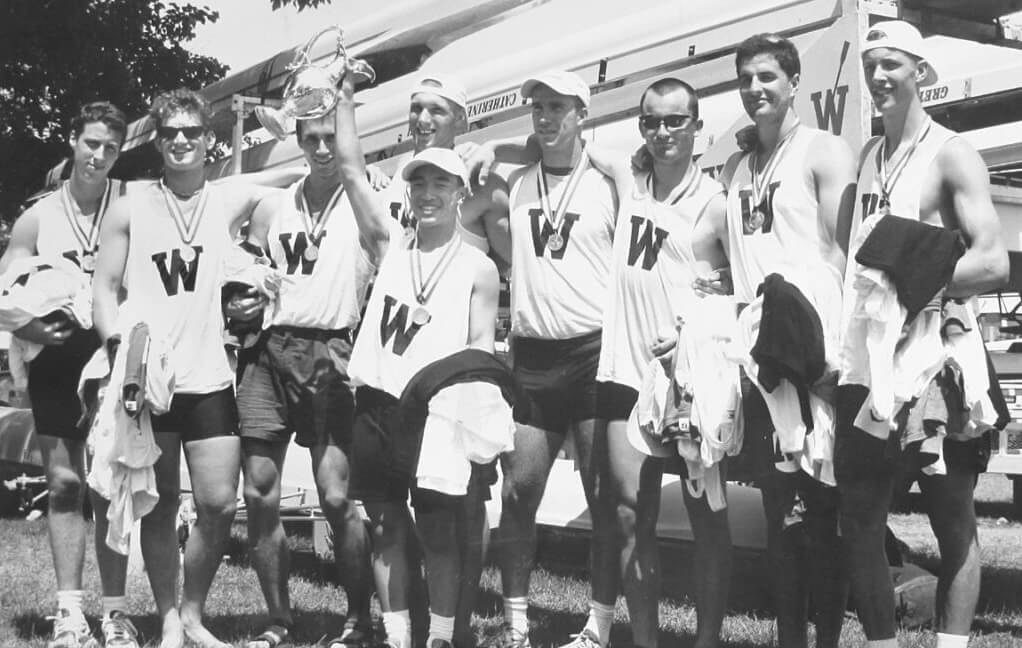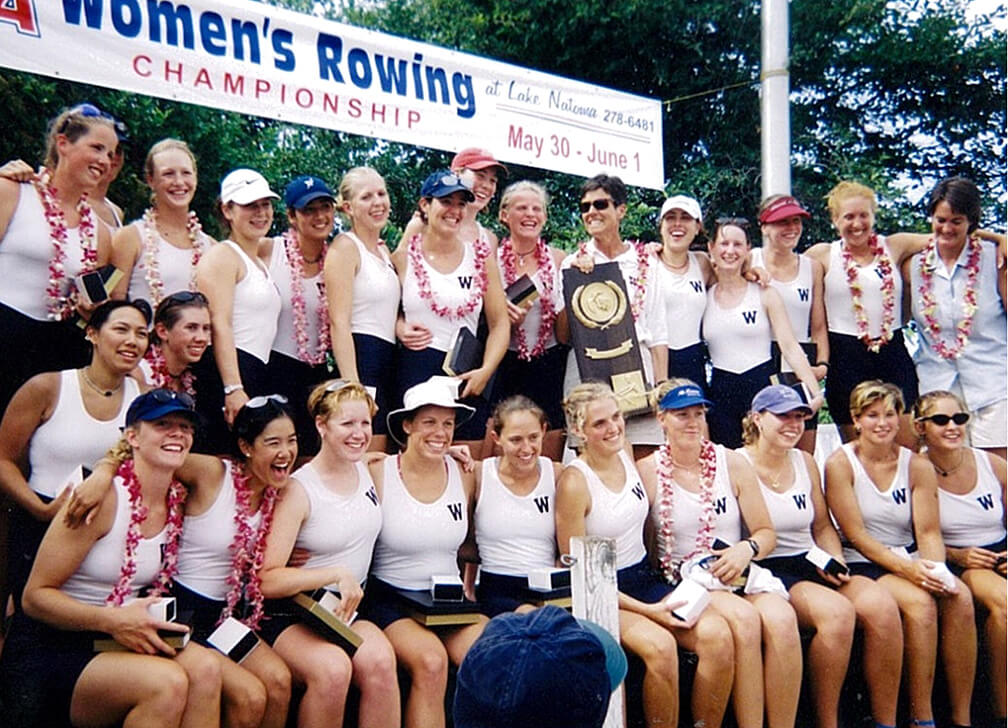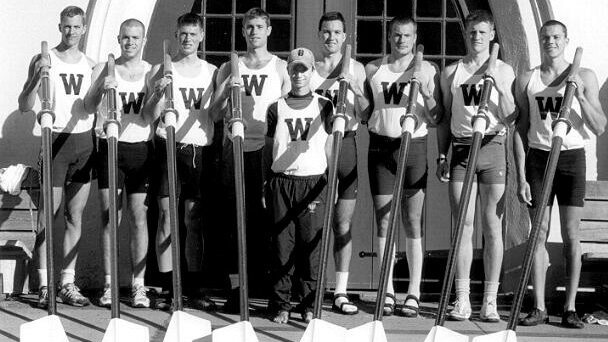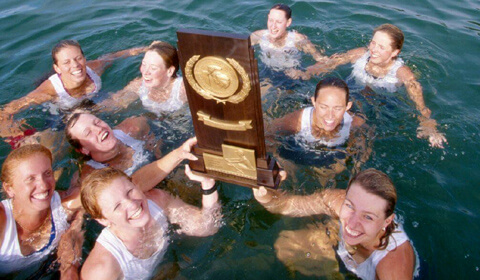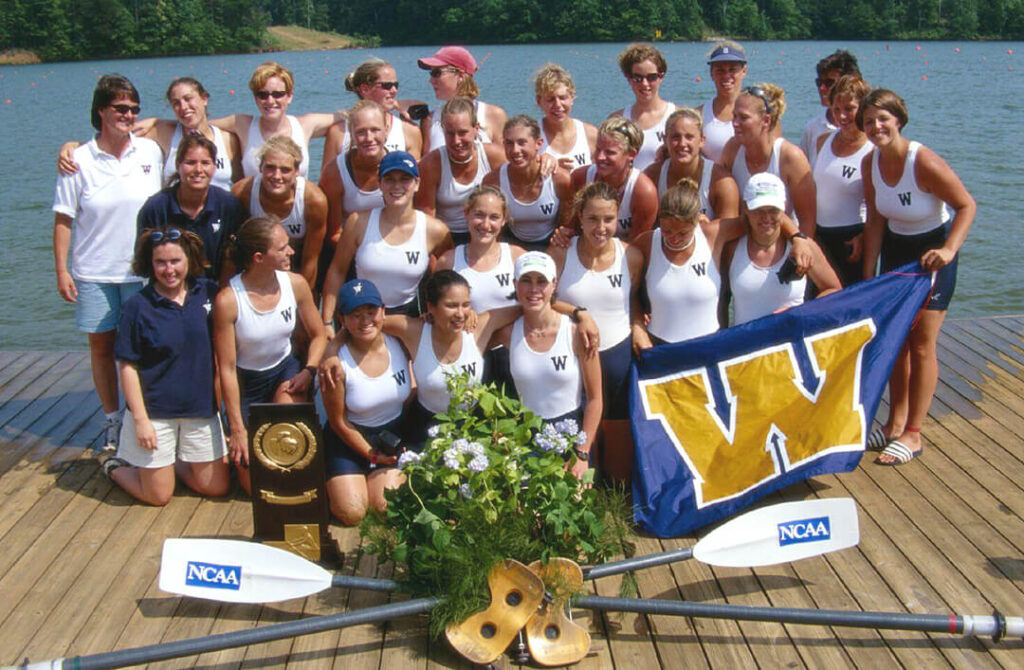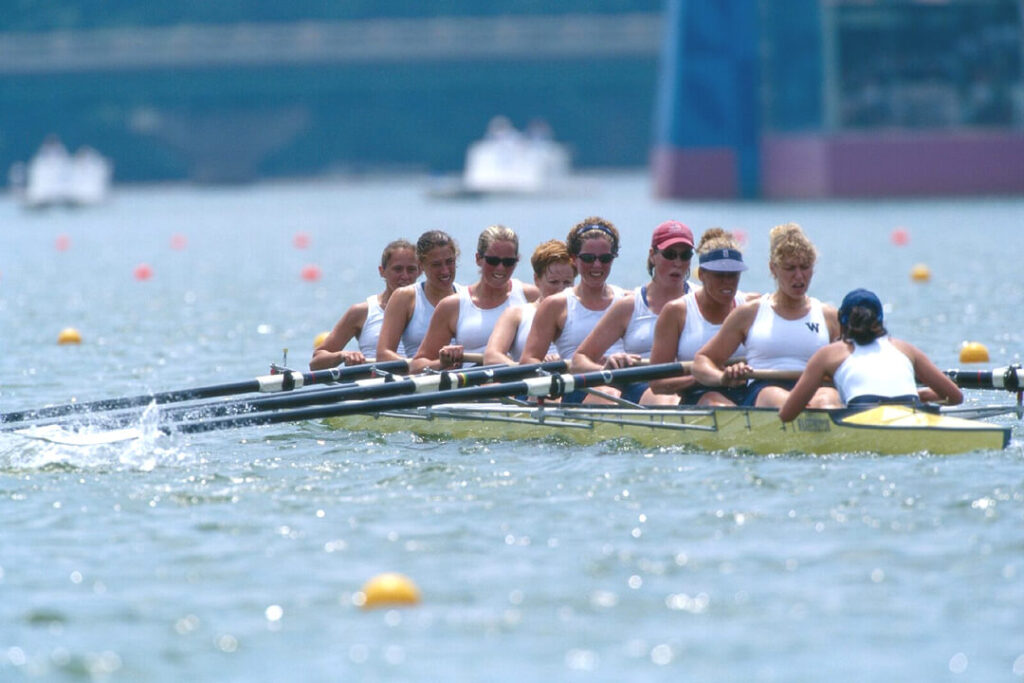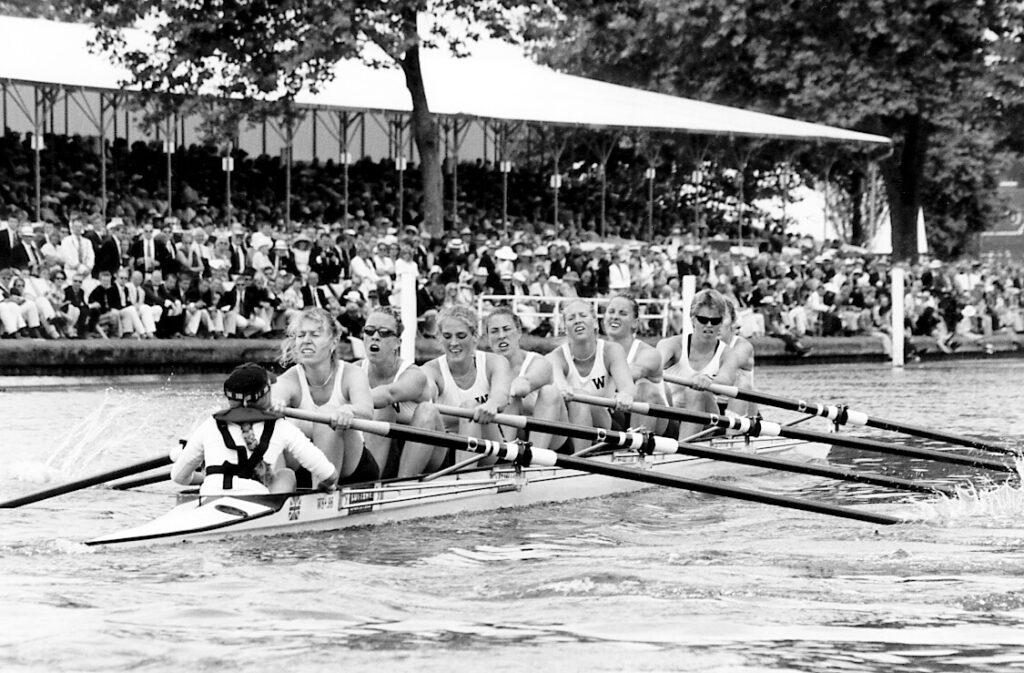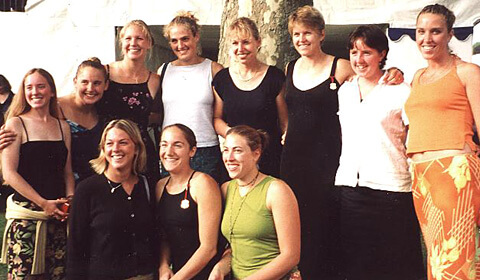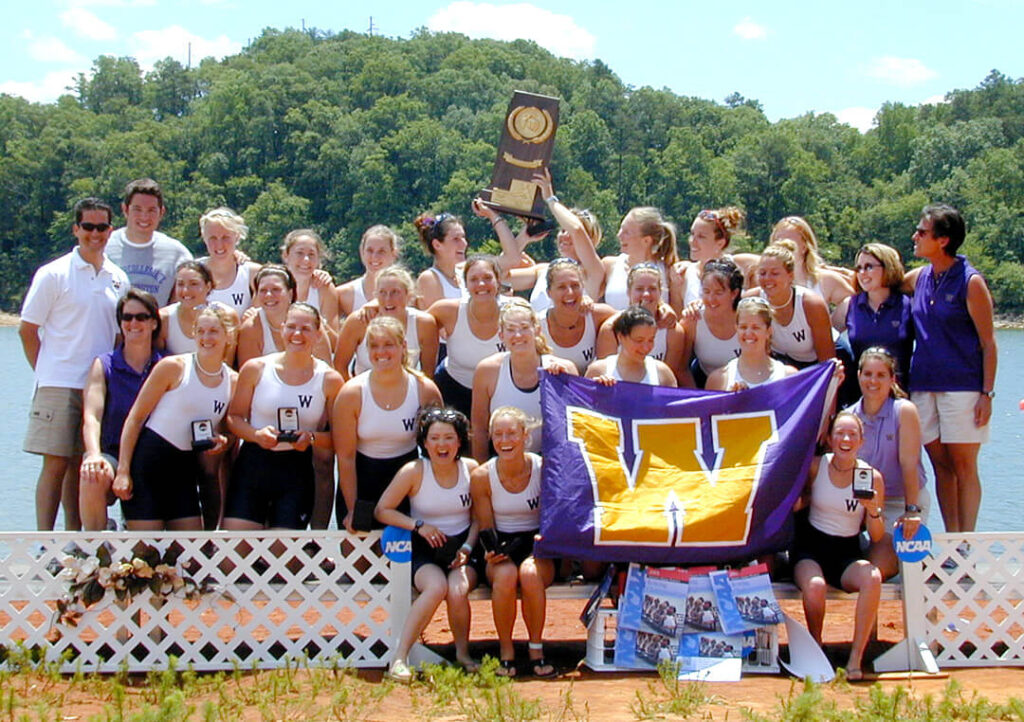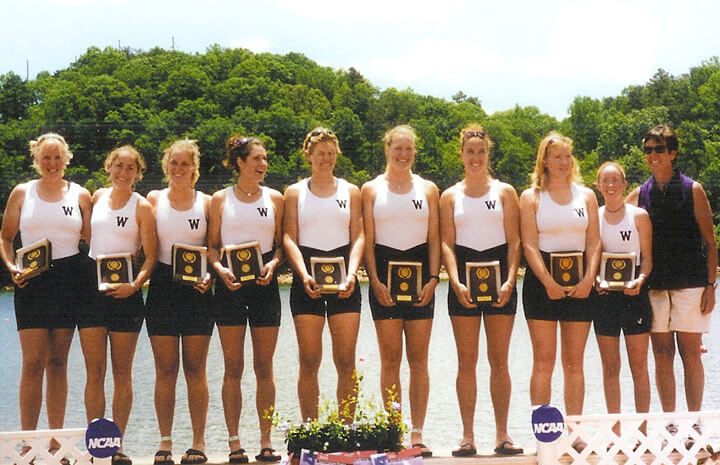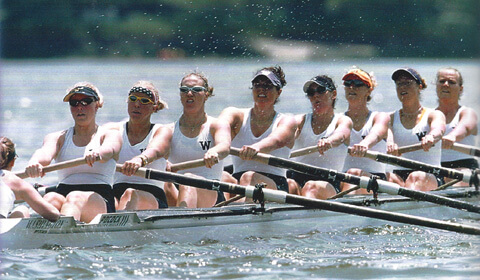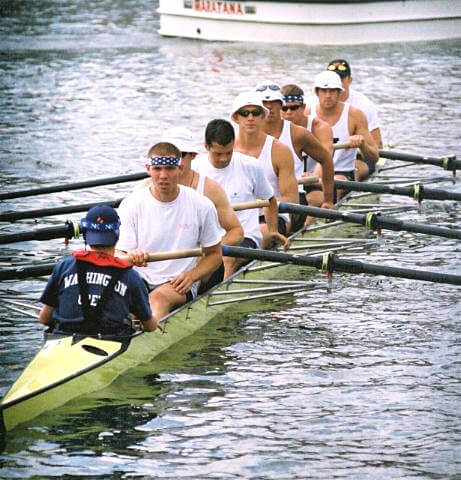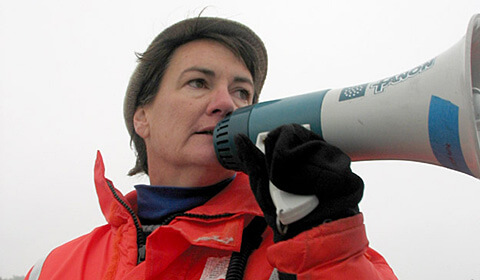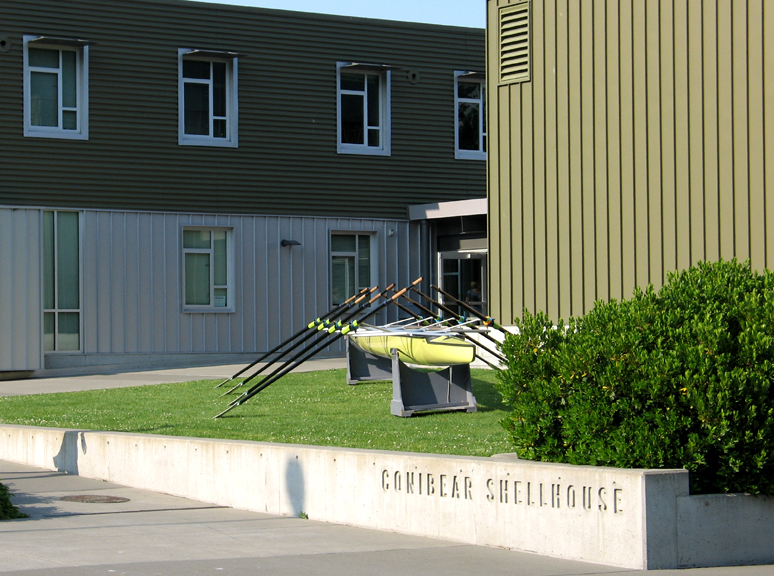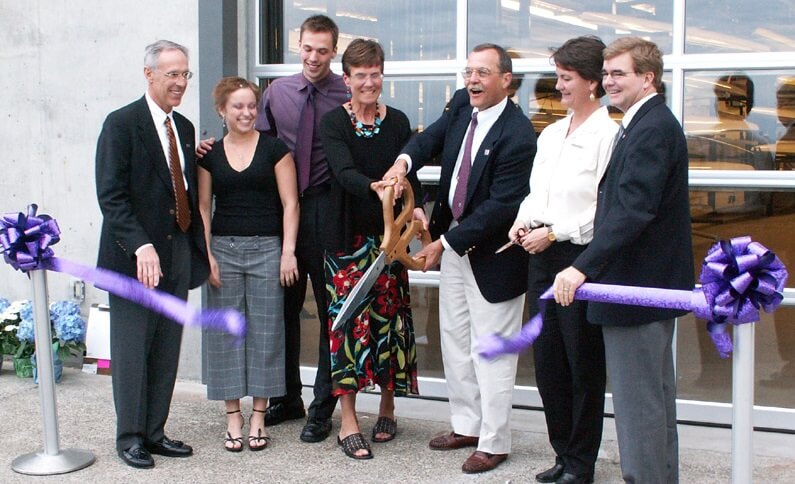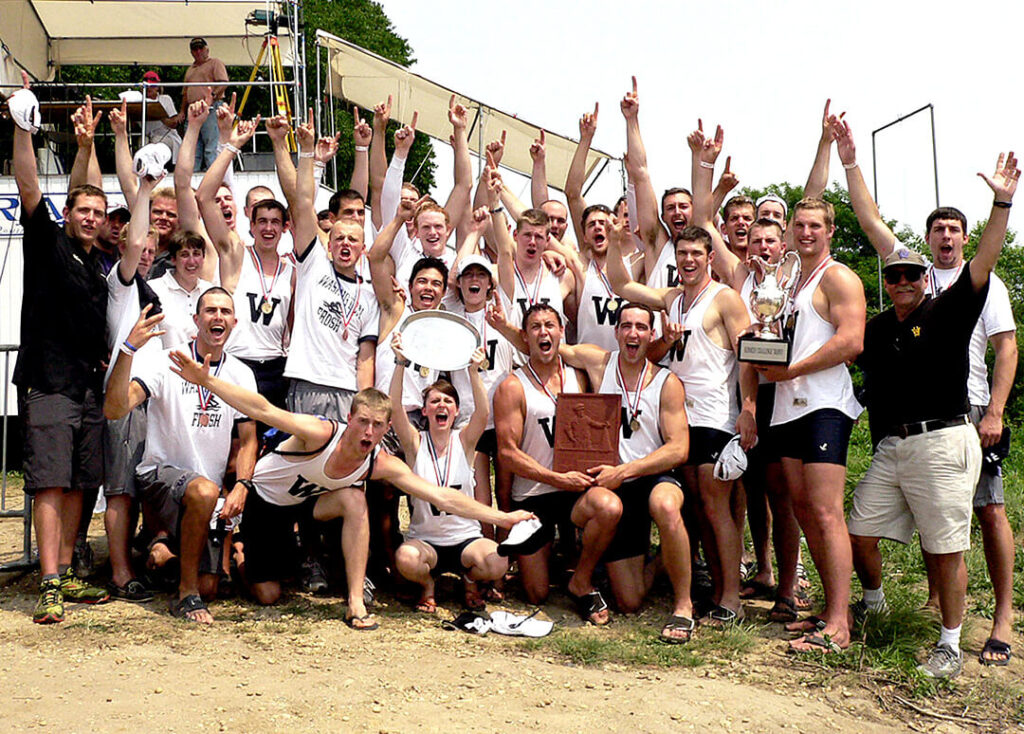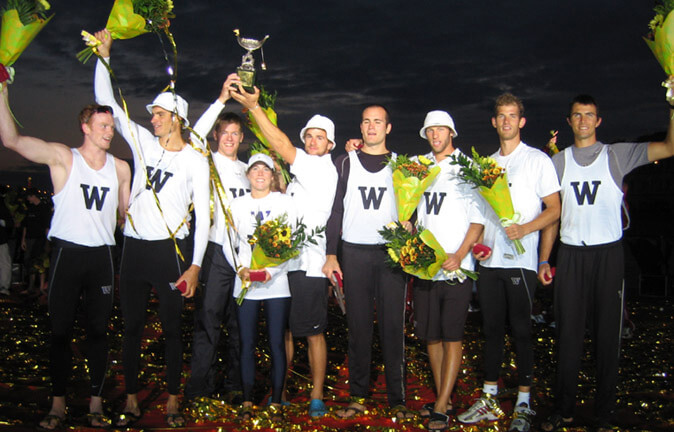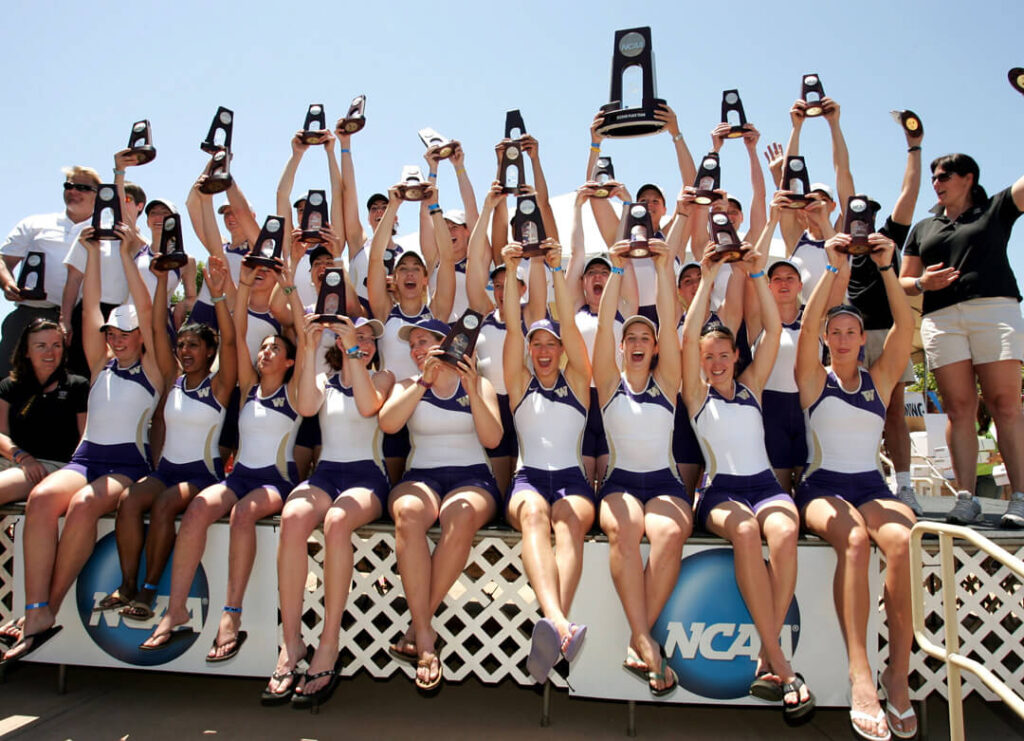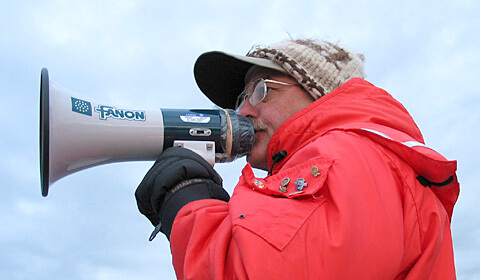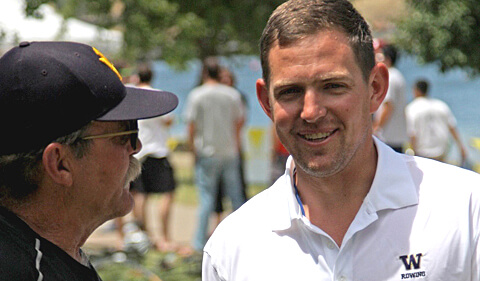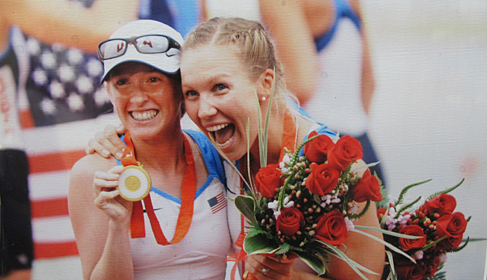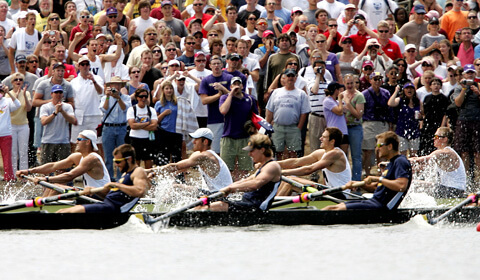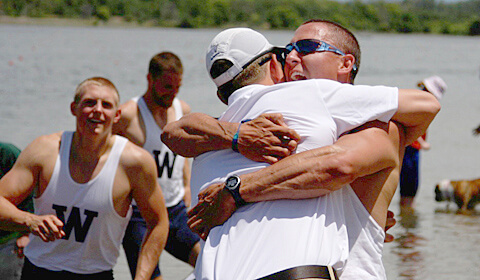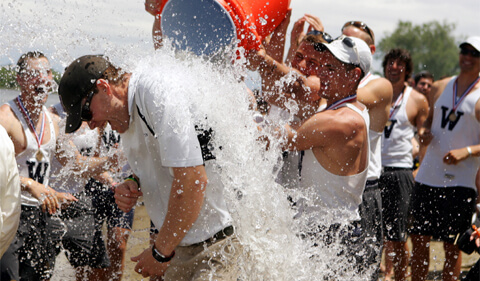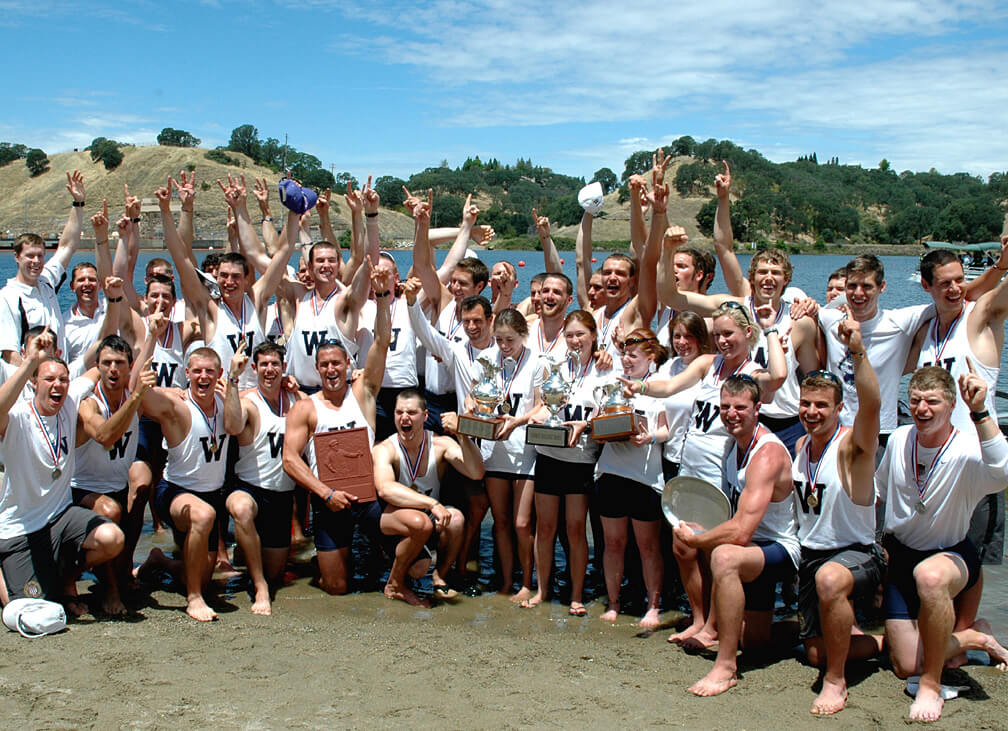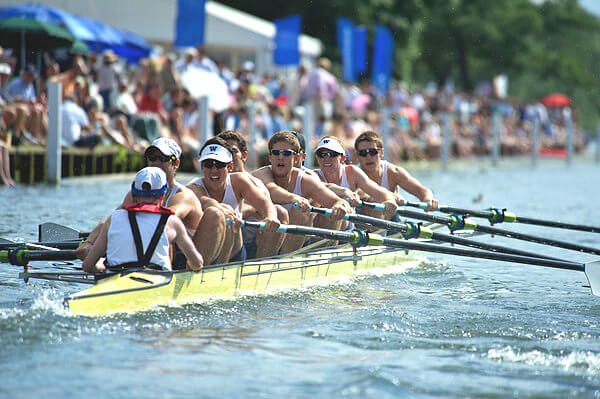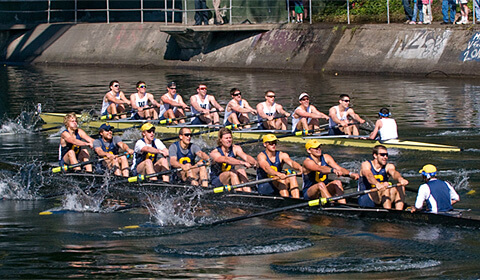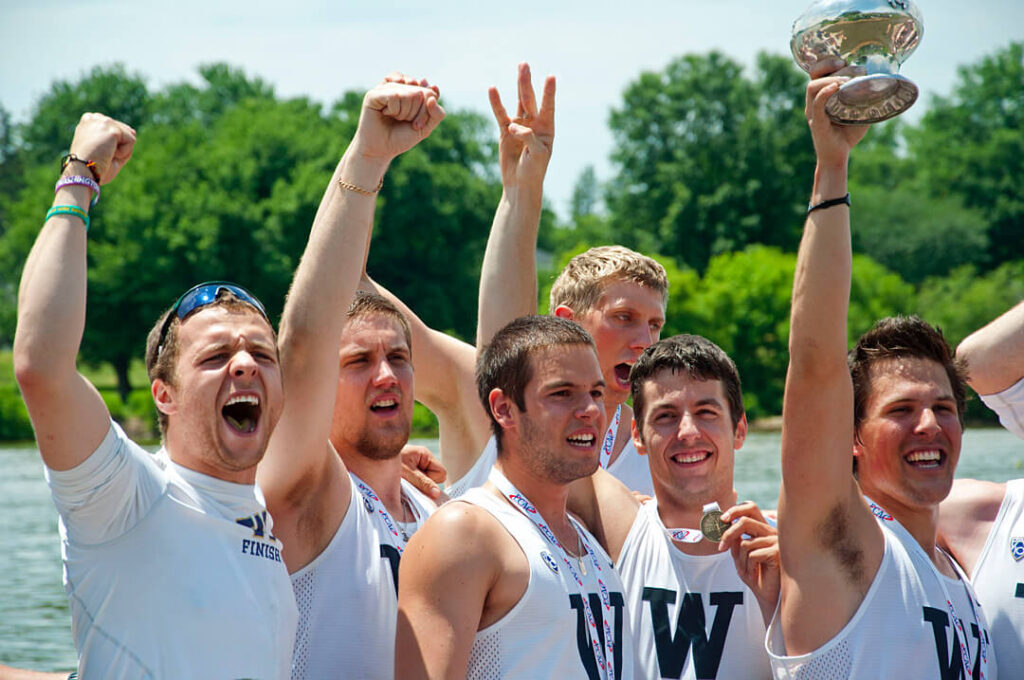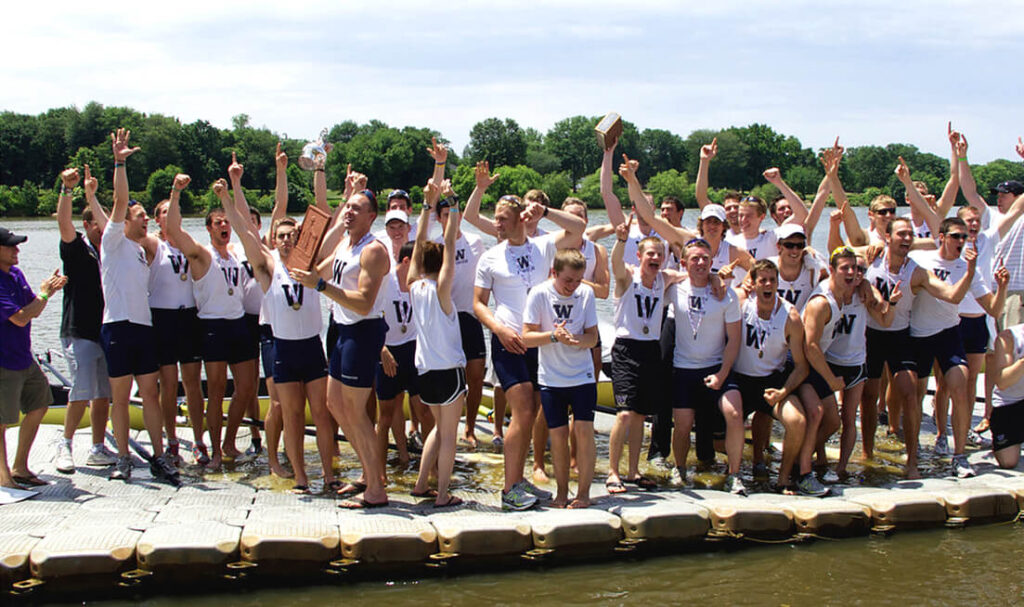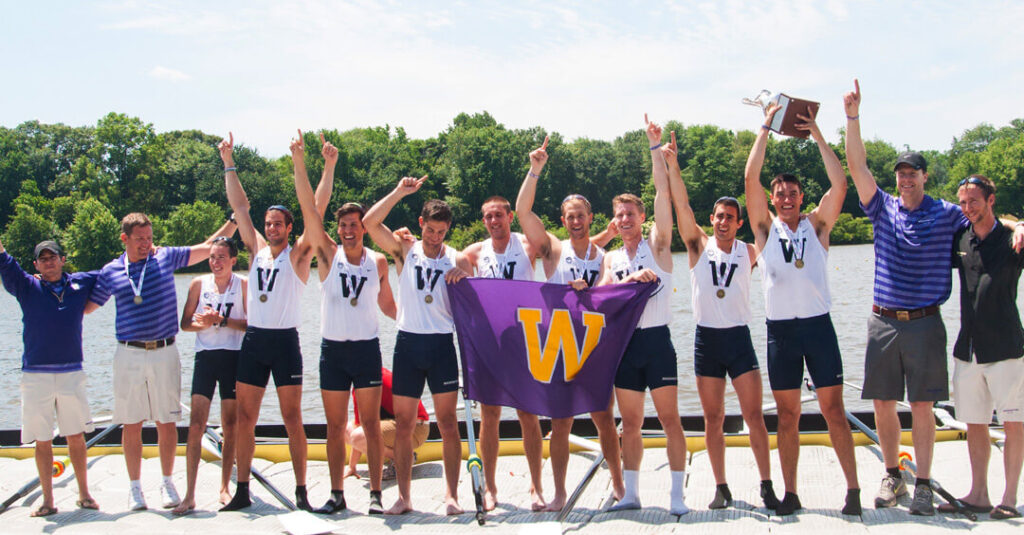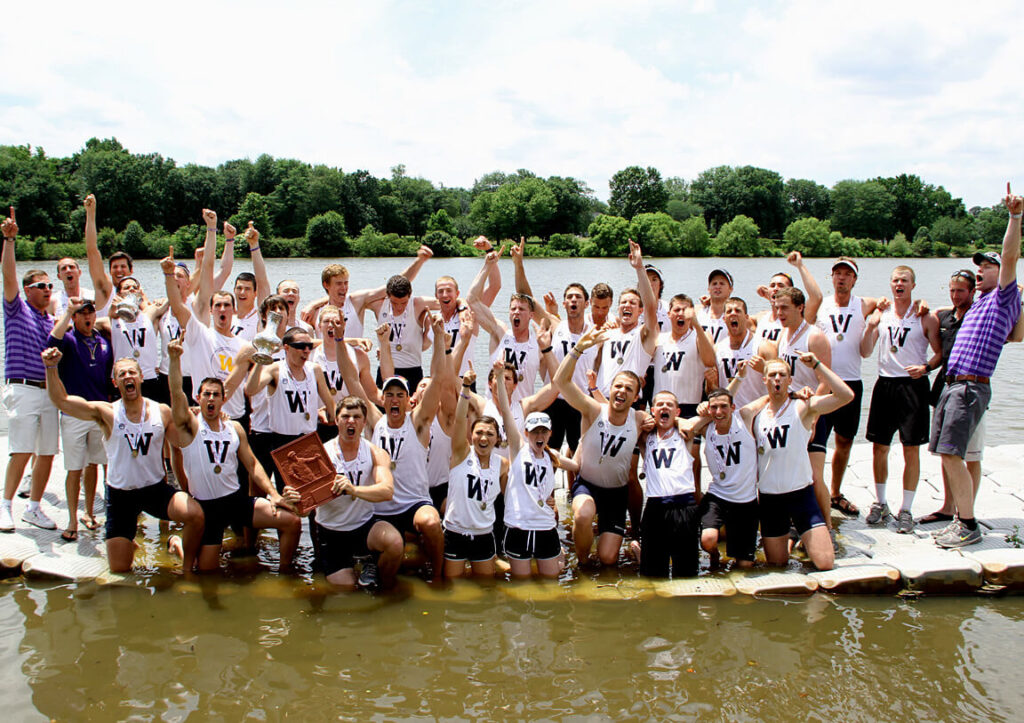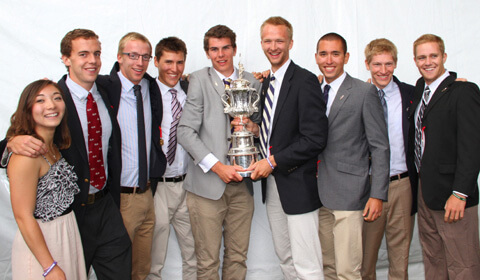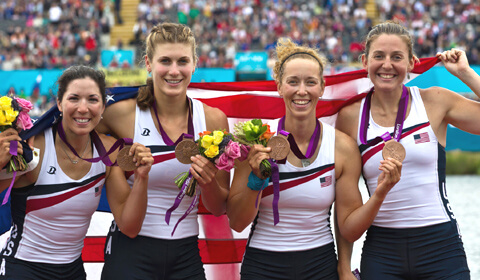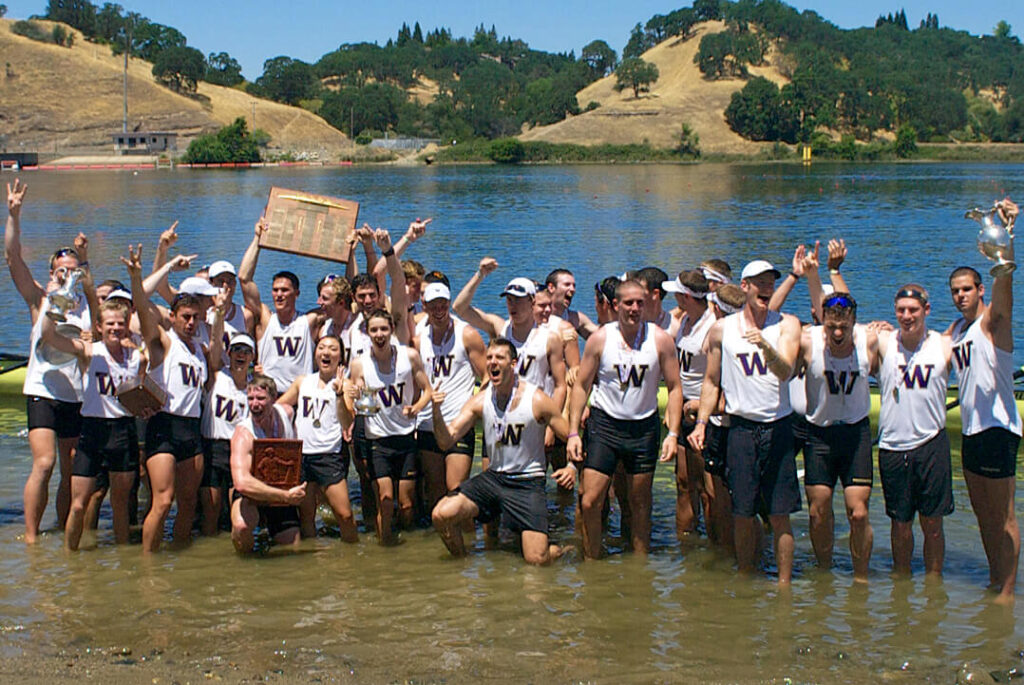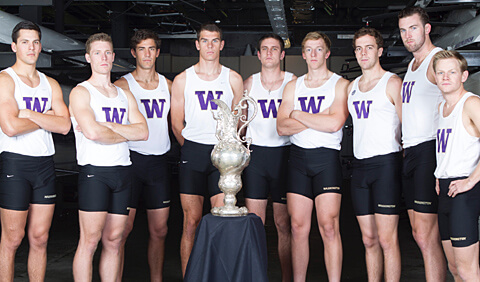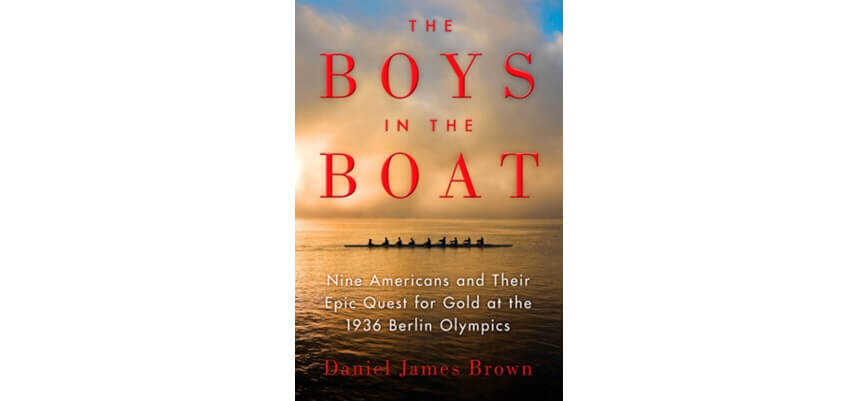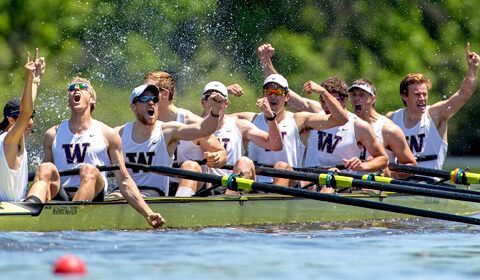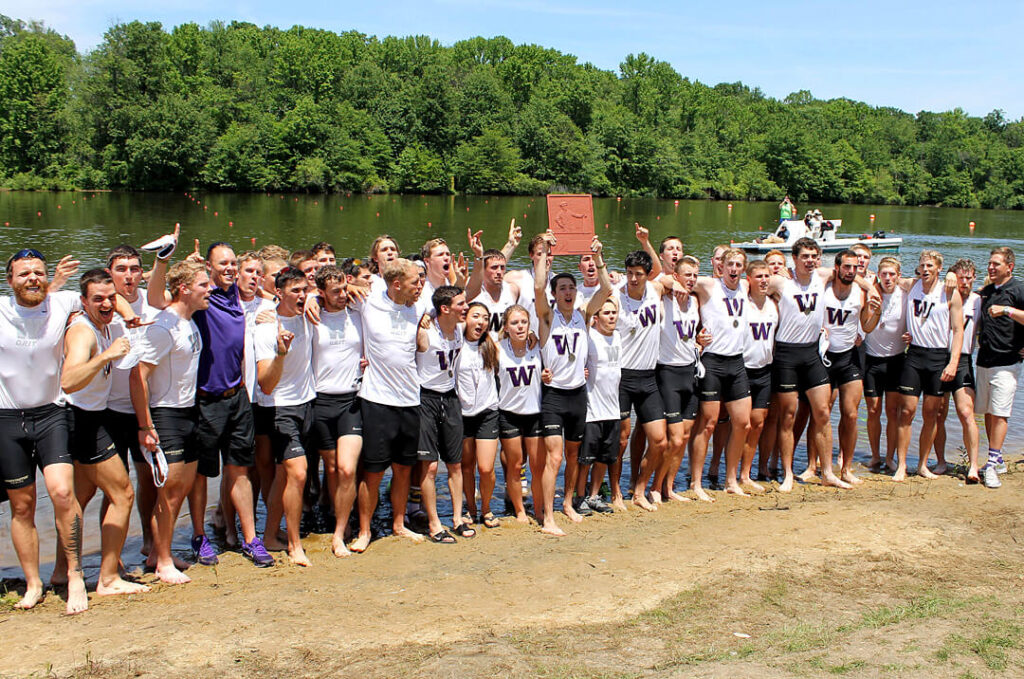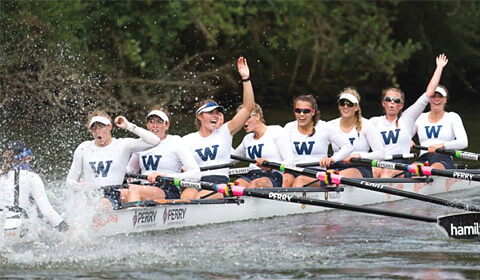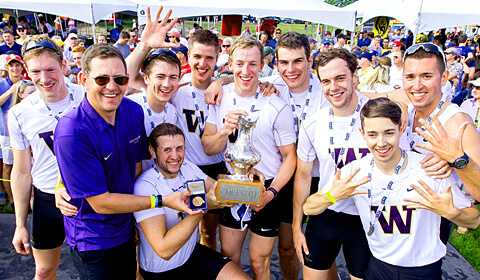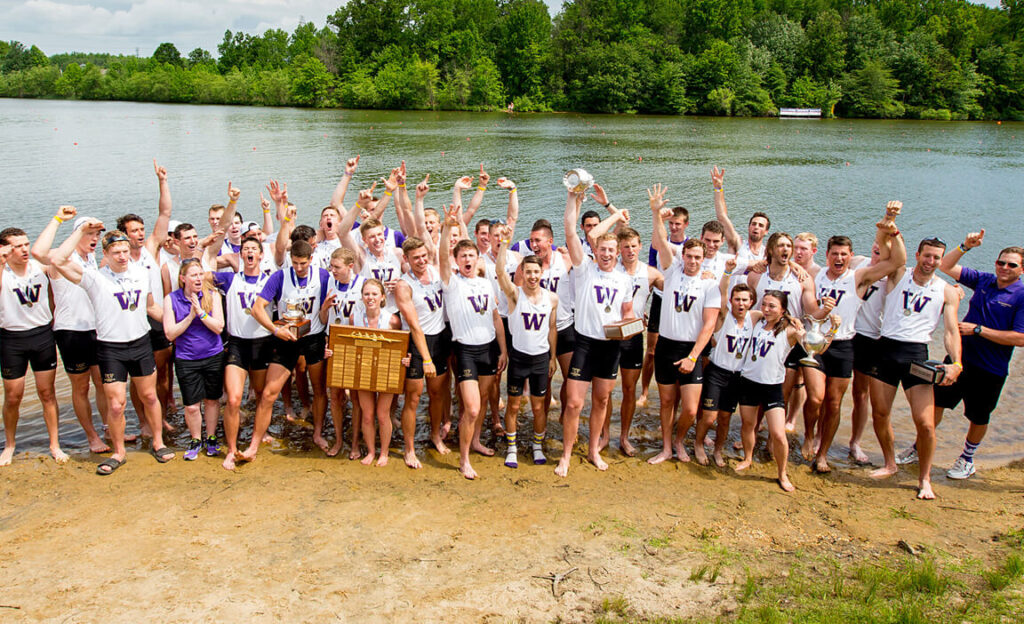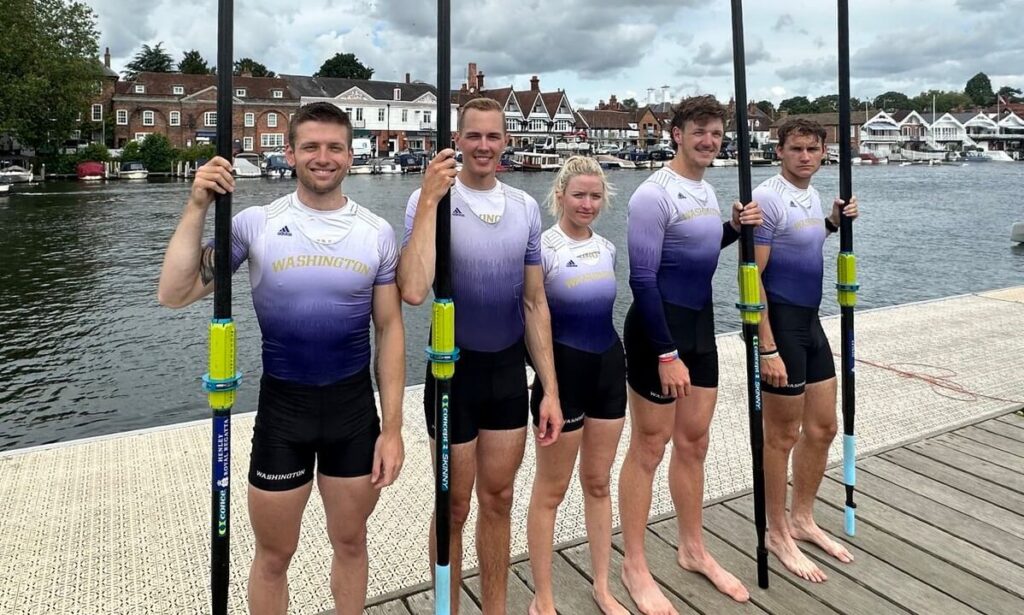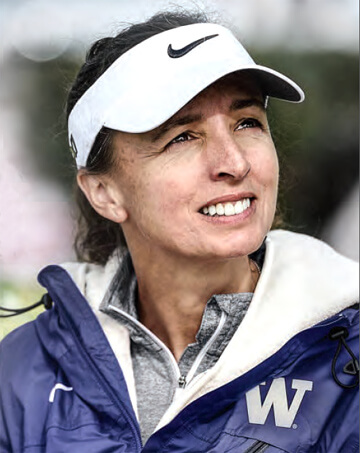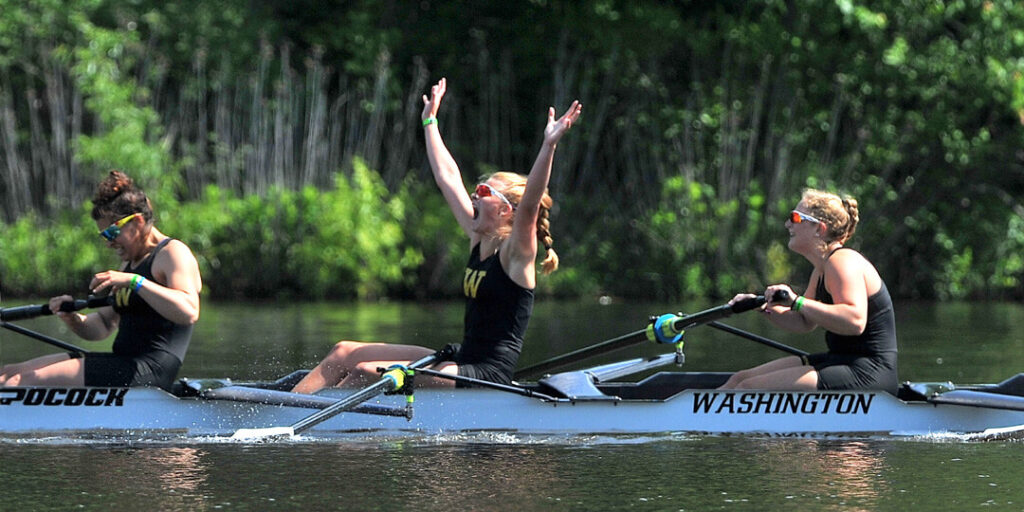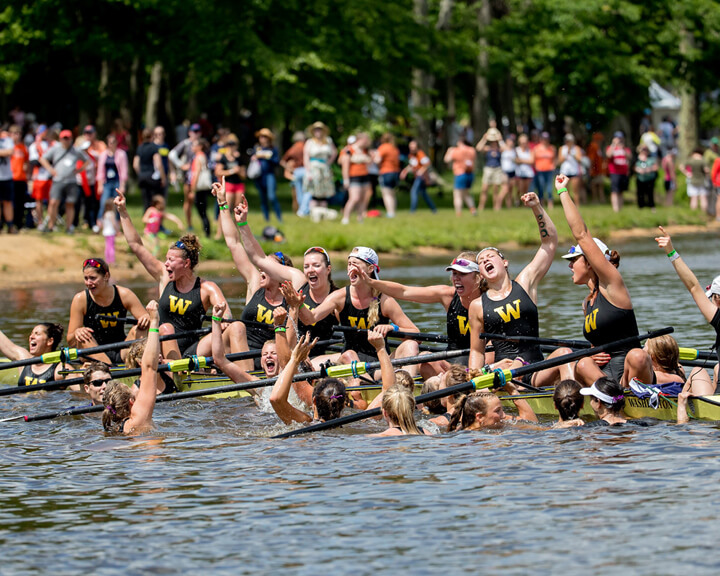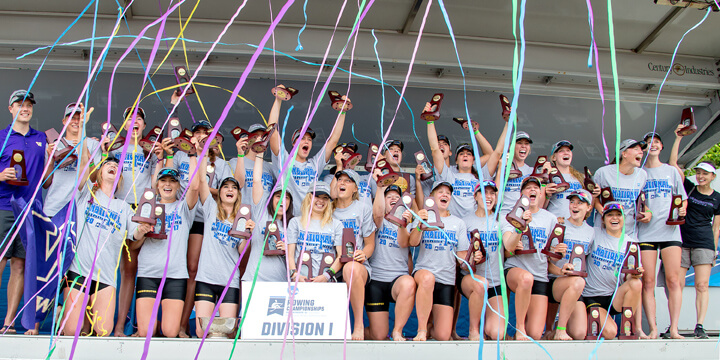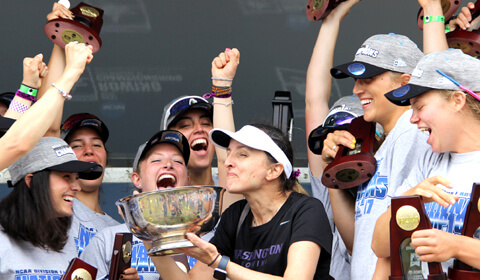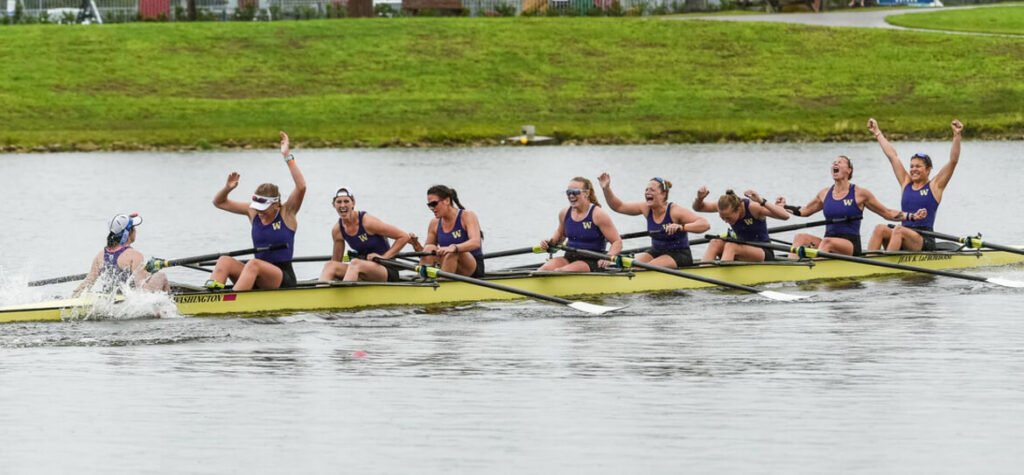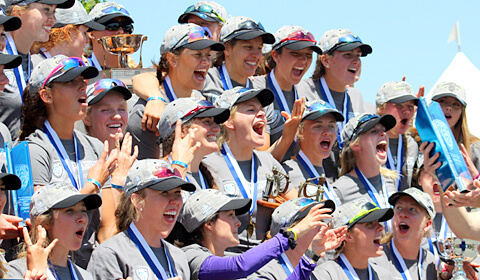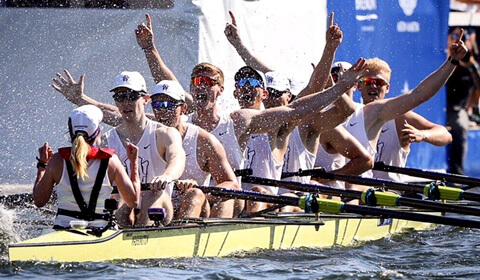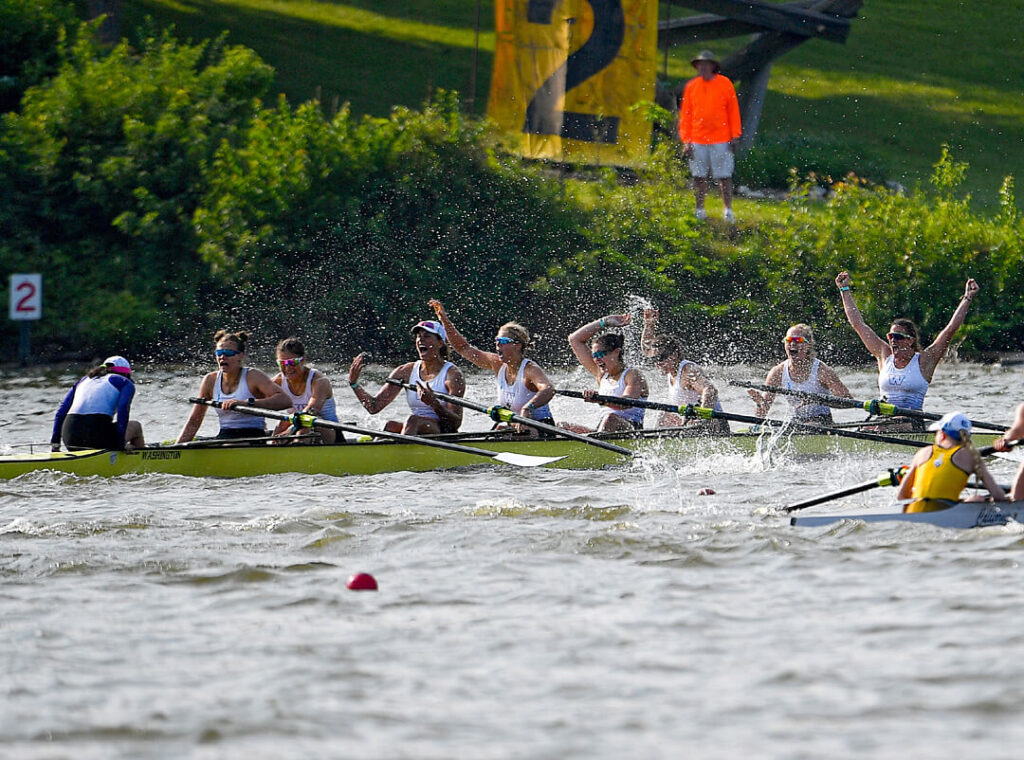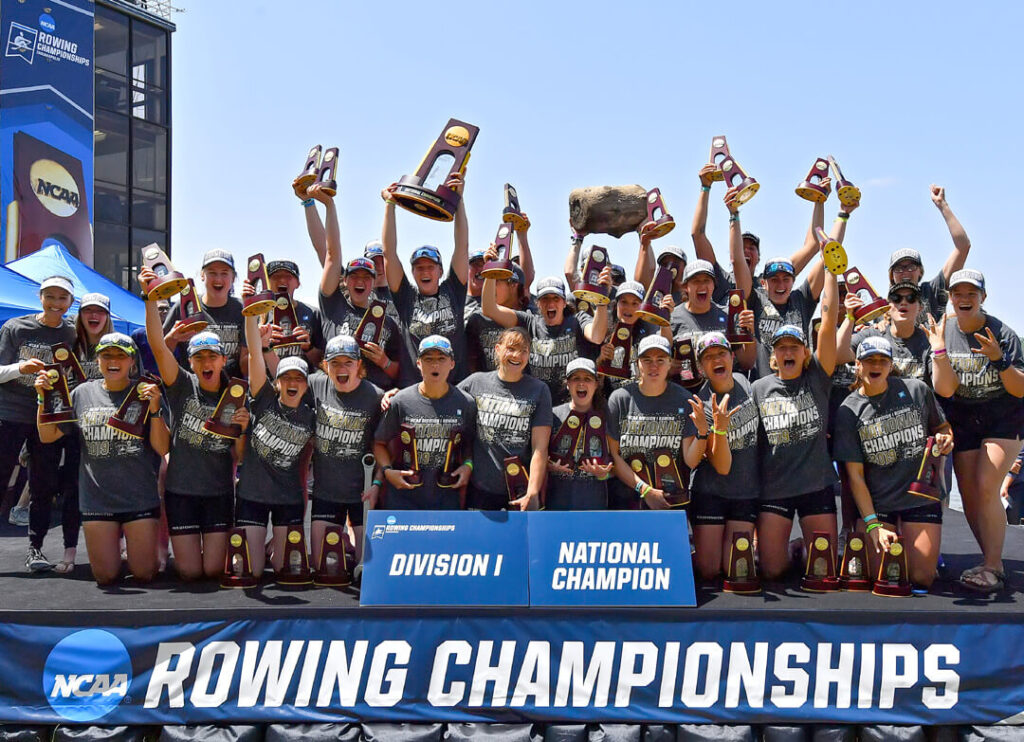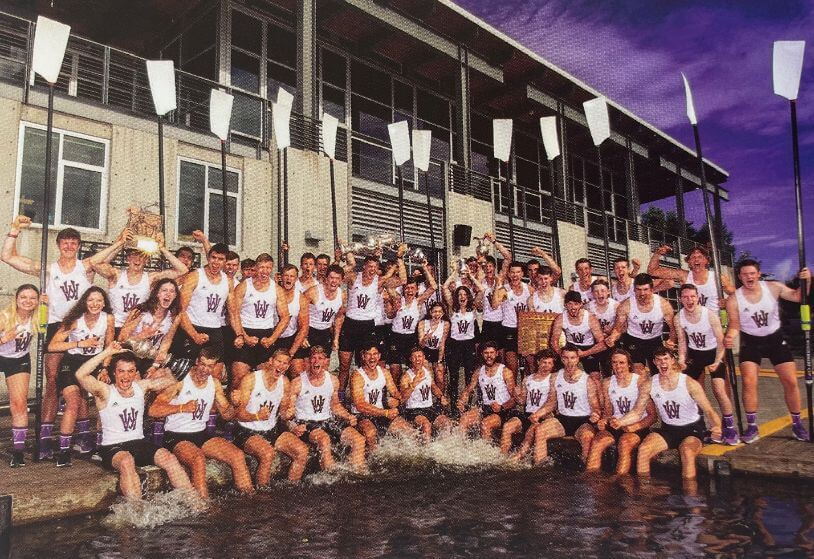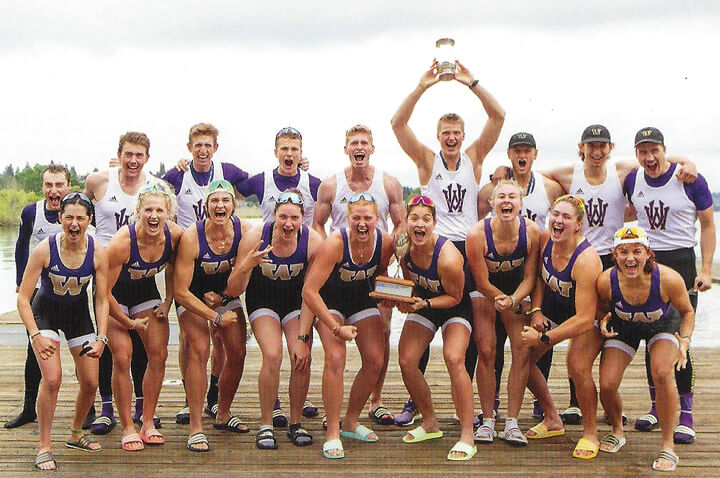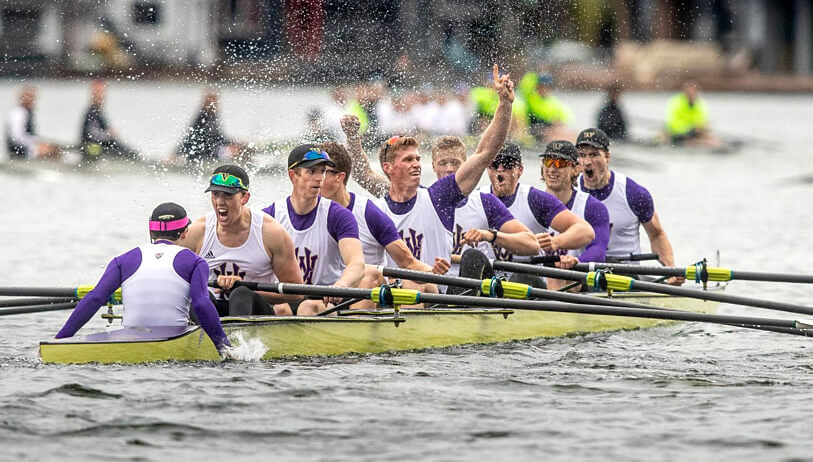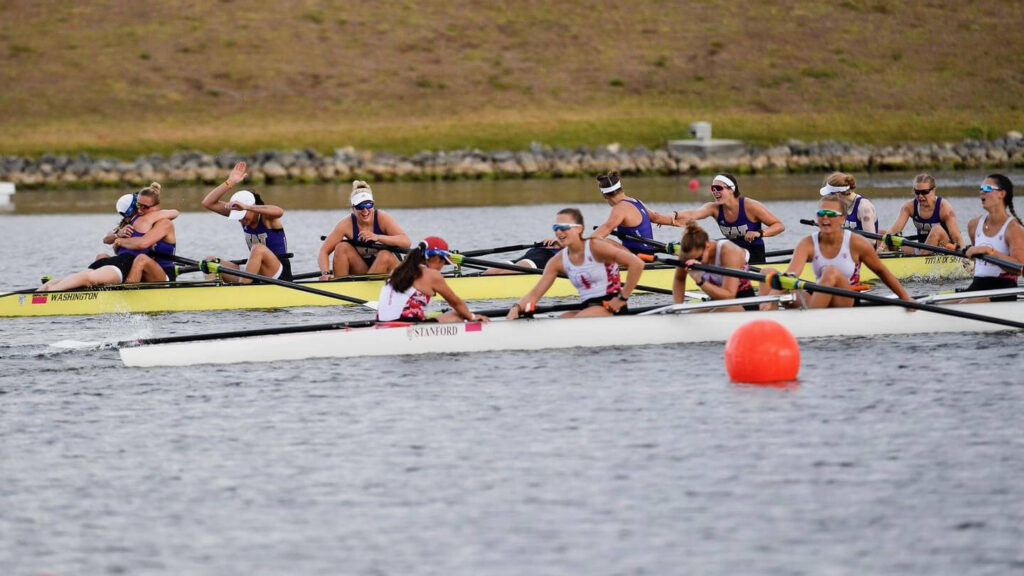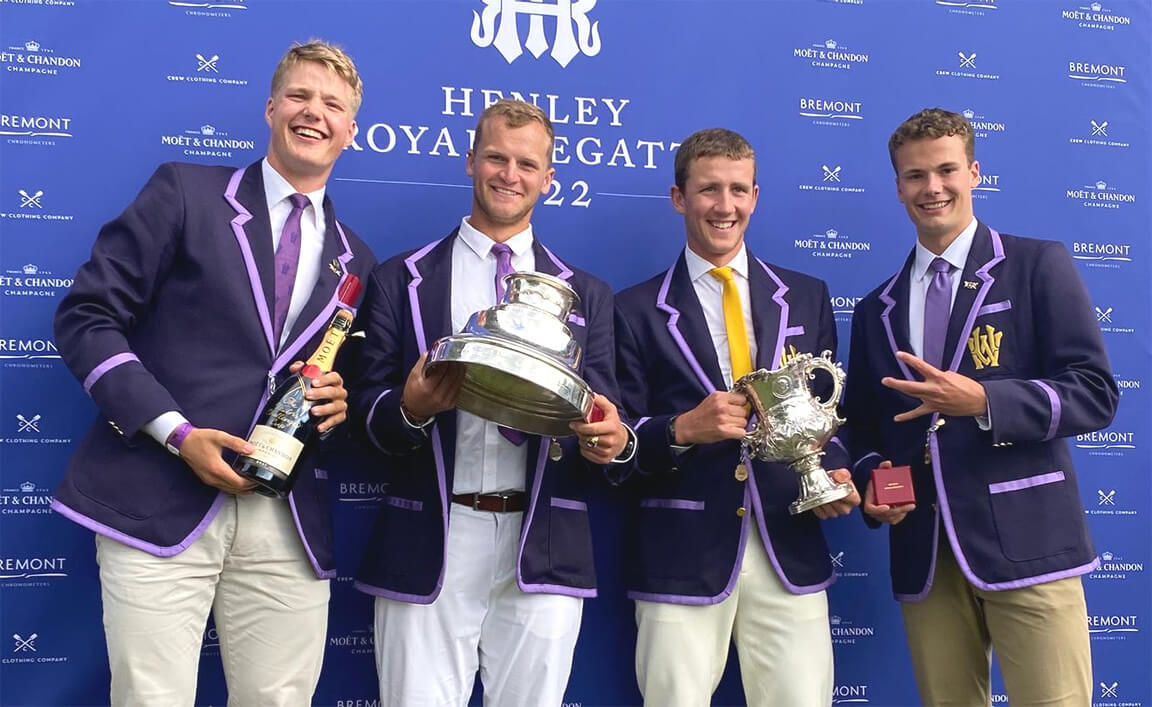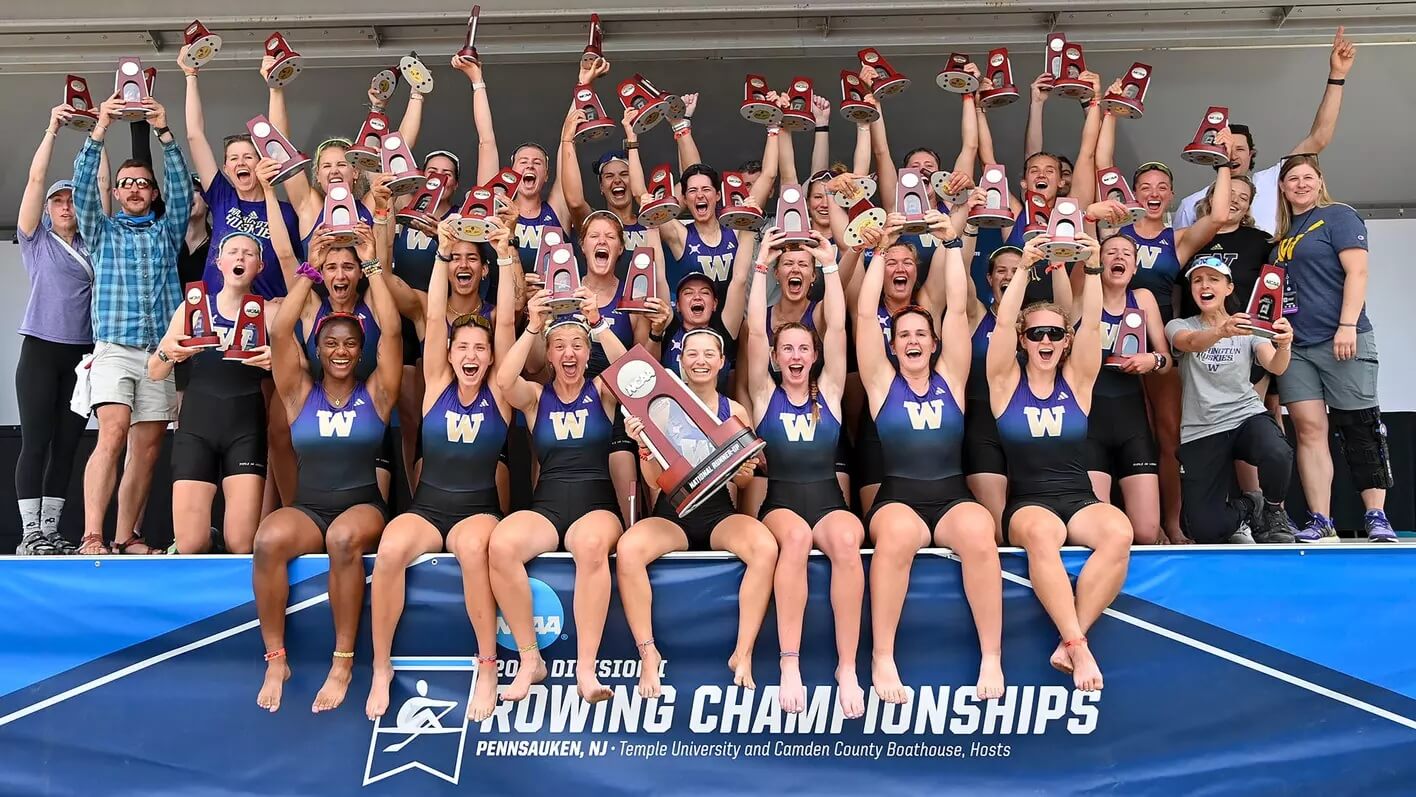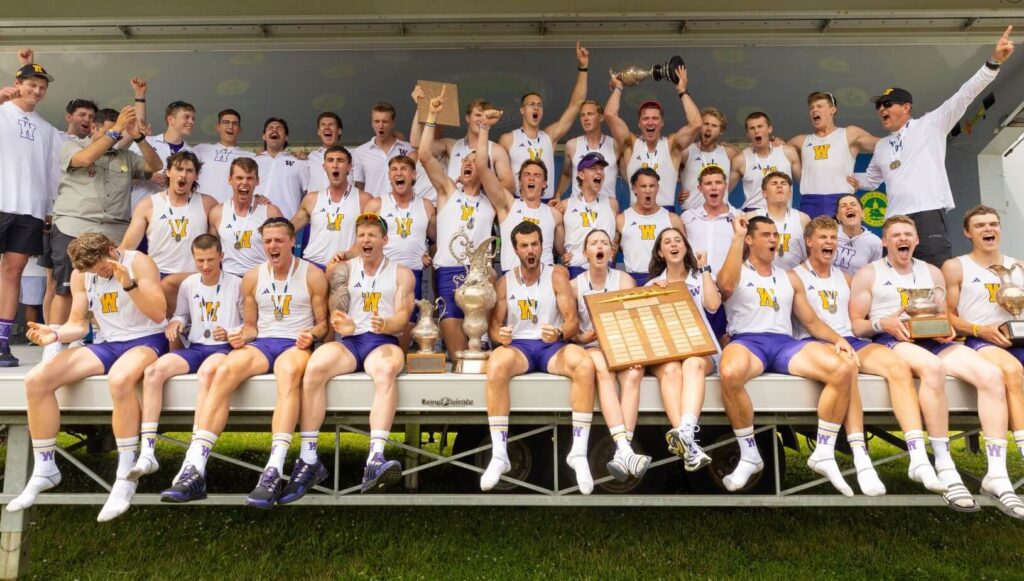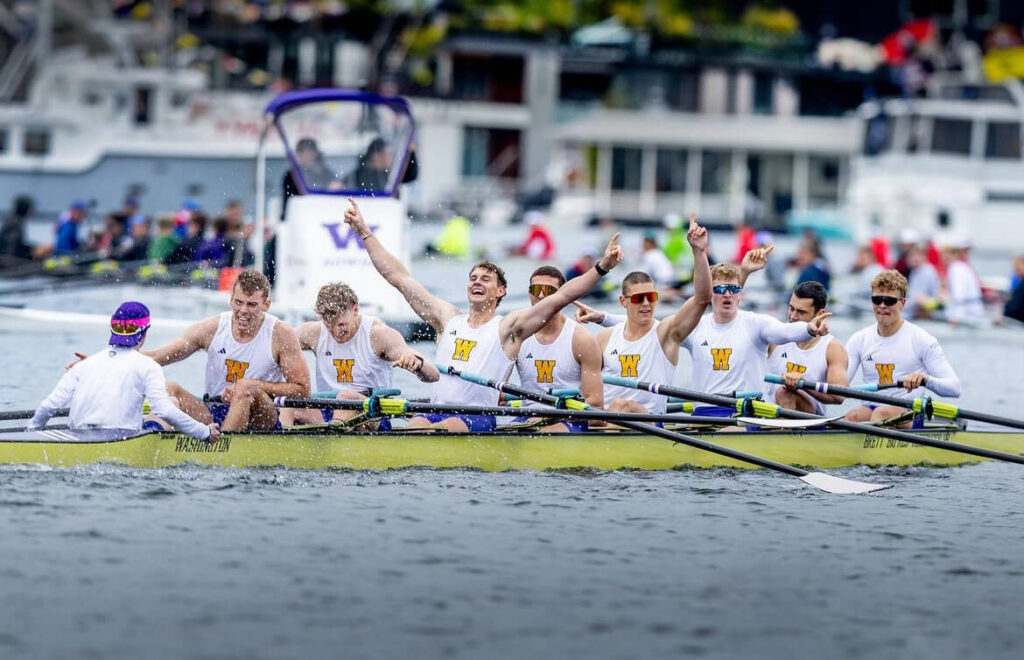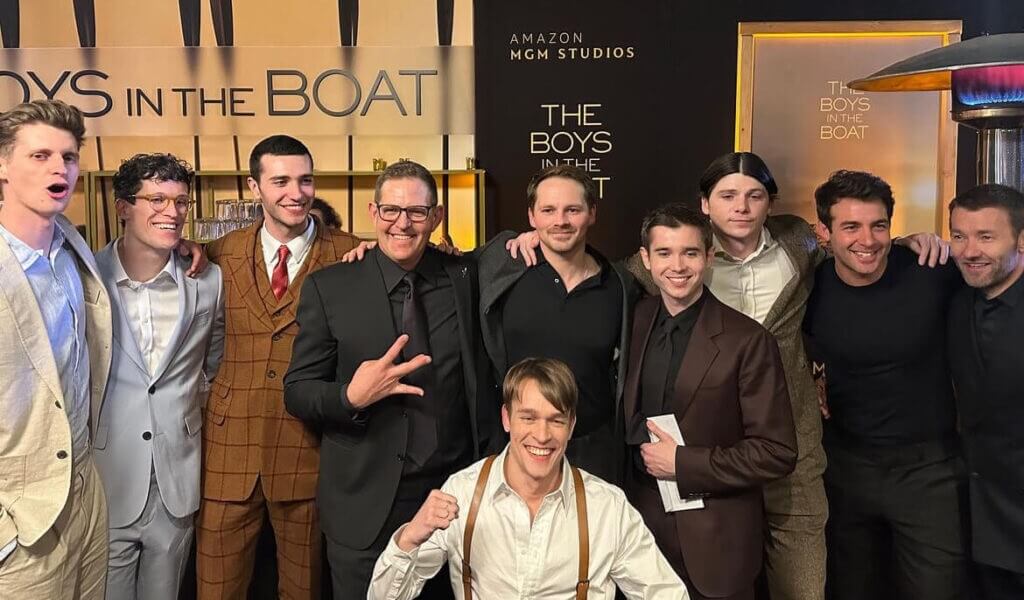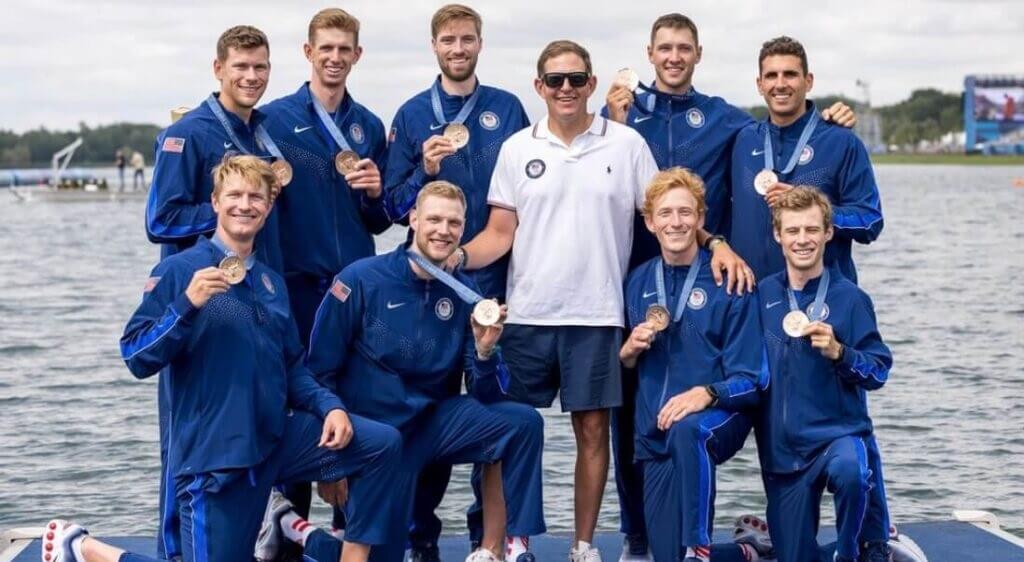Washington Rowing
Historical Timeline
When the original history was published in 2003 for the UW Rowing Centennial, it was written as a continuing story, each year different but each year consistent and built on the same foundation created by Hiram Conibear and the men and women of those earliest years. Our goal has been to continue the theme that Washington Rowing is unique in many ways, but particularly in the consistent values that drive the program, and these values continue today in our coaches and student-athletes that row at Washington.
This timeline does not touch on the human stories that define the program, and I urge anyone reading this summary to read the more in depth history. We have one book – The Boys in the Boat – that covers a small timeframe in the life of the men’s program, and yet every year and generation has similar stories, and students, and coaches and leaders. And every year could be a book. Some do not end as successfully on the water as the 1936 men’s team, but ask any Washington alum at their fiftieth reunion and the response will be the same: an enduring gratitude for what rowing at Washington did for them in their life.
And then finally this: this timeline, as a summary exercise, leaves years out. And yet every year has had a Washington Varsity 8 and a 2V8 and other boats, and some of those years end with National Champions. Some end with Conference champions. Or amazing comeback stories or stunningly bad luck. After twenty years of learning so many of these stories, I firmly believe that if we could line up every Varsity 8 at their prime since our first one in 1907 – and have them race 2,000 meters on one giant race course – the winner could easily not be on this timeline. Because at Washington, every Varsity 8 throughout our history has high-level athletes developed under the same core values; and on any given day in crew racing the “swing” can come… and then anything can happen.
So take this as the summary exercise it is. The real story of Washington Rowing, true since the very beginning, is the opportunity – as George Pocock would say – for young people to reach for the stars and then go put it all on the line as a team, together.
Note: The National Championship race distance, the sponsoring organization, and number of events have all changed multiple times since 1910. Today, for men, a national team champion is awarded (known as the Ten Eyck Trophy) based on points earned in all IRA events; however regardless of team results, the winner of the IRA (Intercollegiate Rowing Association) Varsity 8 race is considered the Men’s Collegiate National Champion. That was also true for the women’s National Championships through 1996; however in 1997, when the NCAA began governing the women’s sport, the officially recognized National Champion became the combined team (V8, 2V8, V4) with the highest point total (cumulative points awarded based on race finish in each event), and not the Varsity 8 race.
A note to our readers:
From the beginning, this project was built for the web: combining the flexibility to easily update and add new material, with the ability to support the history with audio and video. As an example: this timeline was added in August of 2023, over twenty years since content was first being collected and published here. It continues today as one of only a handful of extensively detailed and consistently updated (men and women combined) collegiate sports history collections in the world. The downside to publishing on the web is the ease to which material can be used without consent. Please respect the effort and time that our authors, photographers, and contributors have put into this body of work, and if using any material published here, please contact us first.
All material on the this website, including all writing, photos, video, and audio, are copyrighted. For questions, comments, or history additions, please contact Eric Cohen.
1895 - 1949
The University of Washington moves from downtown Seattle to the new location between Lake Washington (to the east) and Lake Union (to the west). Rowing was taking place by 1896, with various official “start” dates, including 1896, 1899 and 1901. The first Class Day race took place in 1901, along with a “colleges” race (Forestry; vs. Arts and Sciences; vs. Engineering, etc).
Hiram Conibear arrives: Hired by the UW as a trainer for the football and track teams from the Chicago White Sox, he was asked to fill the vacant rowing coach role (for which he had no experience); he accepted, and the sport became his passion. Conibear re-developed the rowing stroke and permanently changed the sport; he is one of only a handful of coaches that influenced rowing globally to the degree he did. At Washington, he set the foundation for the program (Rowing Stewards, Women’s Rowing, Varsity Boat Club and more) that still exist today.
Women’s rowing at Washington: the only public university in the nation with a consistent women’s rowing program at the time. A thorn in the side of the UW Administration (who considered rowing “too rigorous” for women), the program thrived as one of the most popular on campus for female students.
A colorized photo of the 1910 Class Day Champion sophomores. The stroke oar (first on left) is Gretchen O’Donnell, who doubled as the Women’s coach from 1910-1912 and had a major influence on early women’s rowing at Washington. In the article announcing her addition to the coaching staff, the UW Daily noted: “Miss O’Donnell has had considerable experience in rowing and is recognized as being among the best oarswomen in the university.”
The first IRA (Intercollegiate Rowing Association) National Championship competition for Washington at Poughkeepsie, NY. Raising the needed travel funds from the Seattle community, the team surprises the large crowd and National Press by finishing third, establishing Washington as a legitimate national contender and vastly elevating Hiram Conibear’s popularity in Seattle… the downside being a UW Administration increasingly uncomfortable with that newfound status.
Following the end of the war in 1918, Ed Leader assumes the men’s head coaching role and makes a deal with the Navy and upper campus to move into the vacated Navy Hangar on the new (1917) Montlake Cut. That hangar-turned-shellhouse remains in remarkably original condition today and is being restored by the UW; an almost perfect replica was built as a set in The Boys in the Boat production and is featured prominently in the movie.
Ed Leader leaves for Yale along with Dick Pocock; Rusty Callow (a major influence on Washington Rowing) becomes head coach; George Pocock is convinced by Callow to leave Boeing and return to the UW to pursue his passion of building shells (in a shop loft built for him by Callow at the old hangar, the shop still almost fully intact today); Pocock said he was “forsaking the substance and grasping the shadow”.
Washington repeats as IRA Varsity 8 National Champions; Ky Ebright, coxswain under Conibear and assistant to Ed Leader, leaves his coaching role at Washington at the behest of the Stewards to save Cal’s program from extinction. Ebright’s move to Cal as their head coach would prove to be one of the most impactful changes in (global) rowing history, leading to west coast dominance (Washington and Cal) at the Olympics for two decades, and the IRA’s for three.
An even more dominant repeat Varsity 8 National Championship, again with Garhart (the 1941 Seattle Post-Intelligencer “Sportsman of the Year”) at stroke. The ’40 and ’41 teams are still considered some of the best in Washington Rowing history, the “swing” a definition of this group of young men.
Following the end of WWII, and with the IRA still mothballed in 1946, Seattle took the opportunity to sponsor a 2,000 meter National Championship race on Lake Washington by raising the nearly $50,000 needed through a community fund drive. The regatta was a huge success, the Chamber of Commerce following it up in 1947 with an even larger regatta, a race with an estimated 150,000 fans lining the Seward Park course on Lake Washington. These races remain two of the largest spectator events in the history of the sport.
Varsity 8 National Champions and another IRA sweep; the stern 4 (the four oarsman closest to the coxswain in an eight-oared shell) of the JV8 enter and win the U.S. Trials as a coxed 4+, qualifying for the London Olympics. The five young men, coached by George Pocock in a return to his home country of England, win the Olympic Gold on the Henley course.
1950 - 1999
IRA Championships in the Frosh and JVs and a 3rd in the V8 lead Al Ulbrickson’s team (seen here with George Pocock and frosh coach Stan Pocock in the Conny) to the IRA Ten Eyck Team National Championship; Varsity Boat Club Commodore Skip John raises the VBC flag over the new shellhouse marking the first year the men live together year around at Conibear.
The IRA inexplicably bans an undefeated Washington Varsity 8 for the 1957 and 1958 seasons due to an unrelated football scandal, stunning the University, coach Al Ulbrickson, and an infuriated Seattle community (the Seattle Times calling the NCAA and IRA a “sleazy combination”). This watershed decision would lead Ulbrickson to take his undefeated team to Henley and the Soviet Union in 1958 (culminating in one of the greatest rowing upsets of all time, see 1958), but would also carry lasting ramifications regarding Washington’s participation at the IRA into the future.
First “Opening Day” crew races in conjunction with the Seattle Yacht Club down the Montlake Cut in May; IRA Varsity 8 National Champions and IRA Team Champions; Men’s 4+ win US Trials and represent USA at the World Championships; Women’s club team wins the National Championship in the Lightweight 4+, the first collegiate championship won by the women.
The Men’s Varsity 8 are consensus National Champions and runner up in the Grand Challenge at Henley; First of six trips to Egypt that Dick Erickson would take his top rowers for the “Festival of Oars” in Cairo, Egypt; Women’s flyweight 4+ wins the NC, seen here with coach Stan Pocock after rowing in the cedar shell he built specifically for the UW women’s lightweight team: the Lucy Pocock Stillwell.
A sparkling Opening Day with the men’s Varsity 8 – unknowingly the last Washington Men’s Varsity 8 to race in a cedar Pocock shell dating back to 1912 – prevailing over UCLA by a half-length. Two weeks later the men would use a borrowed Carbocraft in a surprising win at the Pac-10’s, and by 1981 were rowing in the first Empacher held by the program. But on this day – in a fitting moment of rowing providence – the name of that last Washington cedar shell to cross the Montlake Cut line in victory? The George Yeoman Pocock.
Dick Erickson appoints his freshman coach, Bob Ernst, as women’s head coach in the fall of 1980, and the results are immediate: the team wins the first of five NWRA Collegiate Varsity 8 National Championships in a row (still unprecedented) from ’81-’85; women’s Varsity 8 and 2V8 win National Titles; undefeated men’s Varsity 8 consensus National Champions; men’s JV8 wins the first Ladies’ Plate title for the UW at Henley.
The inaugural “Windermere Cup”, featuring the Soviet Union’s top men’s and women’s teams racing the Huskies in front of a huge crowd lining the Montlake Cut; Women’s Varsity 8 returns to the top of the national podium by winning the US Rowing Collegiate National Championship; and the team sweeps the Collegiate National Championships (V8, 2V8, V4+) for the first time in history by any team.
A major turnaround for the program as the men re-capture the Pac-10 V8 trophy after a five-year drought, and take home the Copley Cup at San Diego as well – but only after waiting two months for delivery due to a history-making fiasco (a 2k Championship race which the UW won; then stunningly reversed by judges due to a protest (unrelated to Washington) and re-raced two hours later that Harvard then won). By the Pac-10’s SDCC officials had reconsidered, and re-awarded the Copley Cup back to the UW, which they hold high, with the Pac-10 trophy, in this photo.
Bob Ernst sends his JV 8 to the IRA’s (the Varsity National Championship was a single race in Cincinnati won by Brown), the first Washington team to compete at the IRA’s since 1972, and the team surprises the field to win the National Championship. This win sat the stage for Washington to finally return to the IRA, which they did as a full team in 1995.
Forty-two years after the VBC men first moved their bunks into Conibear Shellhouse, the NCAA officially closes the building to live-in athletes, ending a tradition dating back to Hiram Conibear (the original shellhouse is in the background in this photo as varsity cox Kara Schocken and team celebrate their 1995 Windermere Cup victory). Yet as that tradition ends, a new one is re-born as the full team returns to the IRA for the first time in 23 years.
2000 - Present
IRA Men’s Varsity 8 National Champions and Team Champions, beginning an unprecedented (by any team in the history of collegiate men’s rowing) streak of nine consecutive IRA Ten Eyck Team Championships from 2007-2015; Varsity wins the major international event known as the Moscow Race of Champions in Russia over Cambridge, Oxford and Moscow State University.
IRA Team National Champions; Bob Ernst switches back to women’s head coach; Michael Callahan elevated to men’s head coach; Women win NCAA Varsity Four National Championship and the team finishes 2nd in the NCAA; Anna Michelson and Mary Whipple win gold in the USA eight at the 2008 Beijing Olympics.
Washington Men’s undefeated Varsity 8 National Champions cap the first five-event sweep in the history of the IRA: O4+, V4+, F8, 2V8, V8 all gold; 7th eights sweep in UW history; V8 row a 5:21 in the IRA Grand Final, the fastest time in IRA and UW history and two seconds off the World Record; seven former Huskies medal at the 2012 London Olympics (men and women combined, pictured are Megan Kalmoe ’06 and Adrienne Martelli ’10 with bronze in the USA Quad); and the Washington Men’s Freshmen win the Temple Cup at Henley. 2012 marks the most dominant full-team performance in the history of men’s collegiate rowing.
Listen to the 2012 IRA Varsity 8 Race Call:
Listen to Michael Callahan describe the 2012 team:
IRA Varsity 8 and Team National Champions and the second five-event sweep in the history of the IRA: O4+, V4+, F8, 2V8, V8 all gold; 8th eights sweep in UW history. Daniel James Brown’s The Boys in the Boat, the story of Joe Rantz and the 1936 Washington rowing team, debuts and becomes a national and international Best Seller.
The Women’s Varsity Eight with a comeback win for the ages at the NCAA’s: trailing in 6th place late in the Grand Final, coxswain Marley Avritt asks her team to re-commit to each other. “It was sheer human will,” said head coach Yasmin Farooq of the response to Avritt’s request, as the team blew past the five other teams in the last 500m to win with an NCAA record time in what will remain one of the most legendary comebacks in Washington history. “At every championship we always talk about our teamwork within each boat and across all boats,” Continued Farooq. “We talked about it last night before the finals, about not only pulling for the people in their boat and the people that are here but for all the incredible people back home supporting us this entire year.”
The win solidified the Team Championship and completed the repeat of the 2017 V8/2V8/V4 Sweep at the NCAA’s; the UW women are the only team to sweep the Women’s National Collegiate Championships and they have done it three times: 1987 (USRA); 2017 (NCAA); and 2019 (NCAA).
Entering the NCAA National Championships seeded 8th in the V8 and 4th in the 2V8, both crews would save their best race of the season for last. With a hard-fought silver in the 2V8, followed by a relentless Grand Final and stunning silver medal for the V8, the combined result would earn the full team a second-place finish at the 2023 NCAA’s, making it an unprecedented 6th year in a row on the NCAA podium (top 4) for Washington as a team. “Everything we do is built towards this moment,” said Coach Yaz Farooq. “The results that you saw on the water today are really the results of our entire roster. None of this happens without all of those women back home and, specifically, the work that the first varsity eight and the second varsity eight did together all year.”
A non-stop and history-making year for the program. It began in December, with the world premiere of the George Clooney directed and long-awaited Boys in the Boat movie (a 2024 box office hit), and culminated in a National Championship for the Men’s V8 and the 11th eights sweep for the program (V4, 3V8, 2V8 and V8 all gold) at the IRA National Championships in June. Along the way the men defeated Harvard in a renewal of the Tom Bolles Cup dual race (last raced in 1975; see 1936 for more on Tom Bolles), set a new record on Cal’s home course at The Dual, and won the last Pac-12 Championship, as the vaunted “Conference of Champions” disintegrated and scattered in the new era of NIL and million-dollar college quarterbacks. In the summer, Michael Callahan would coach the USA Men’s Eight to Olympic Bronze at the Paris Olympics, his crew including three athletes from Washington; all told, eleven former Washington rowers, men and women combined, would medal at the 2024 Olympics, the most in program history.

